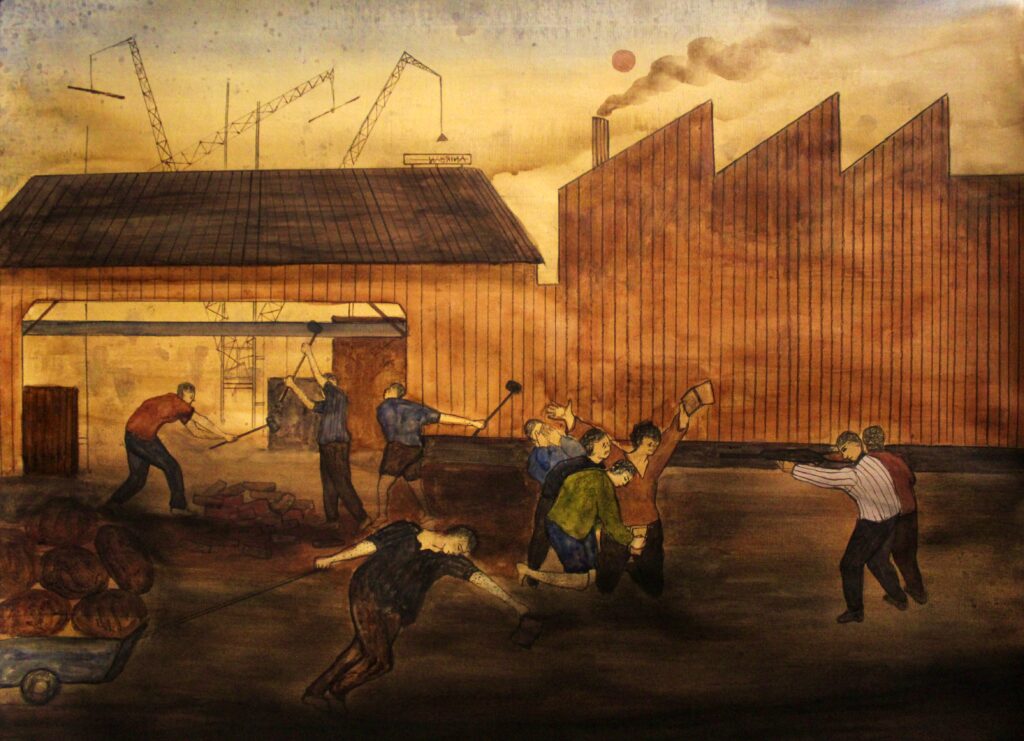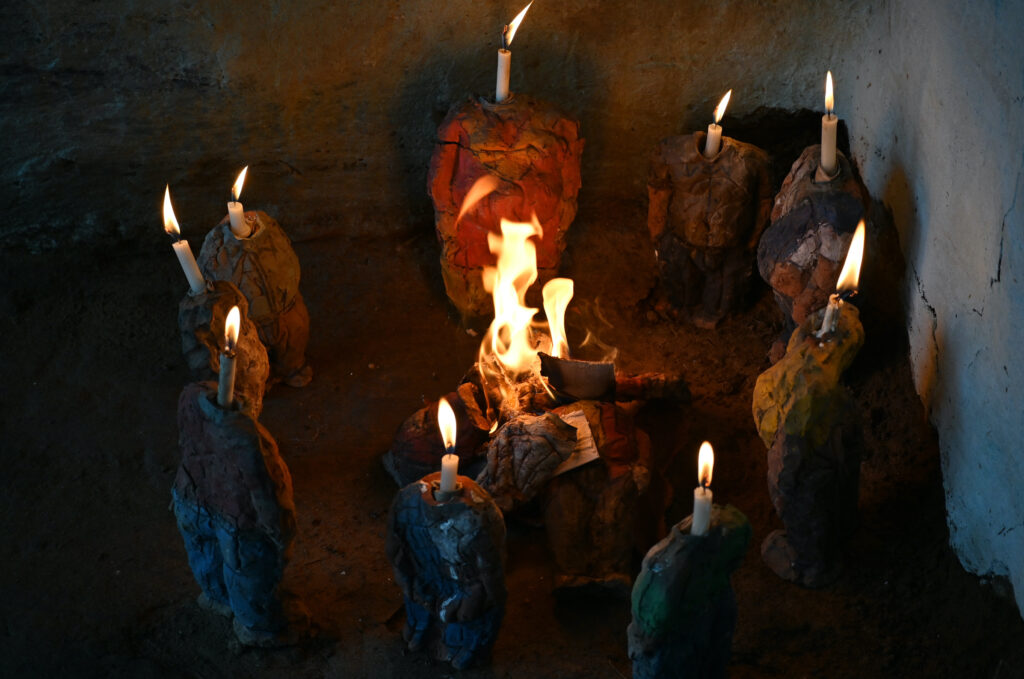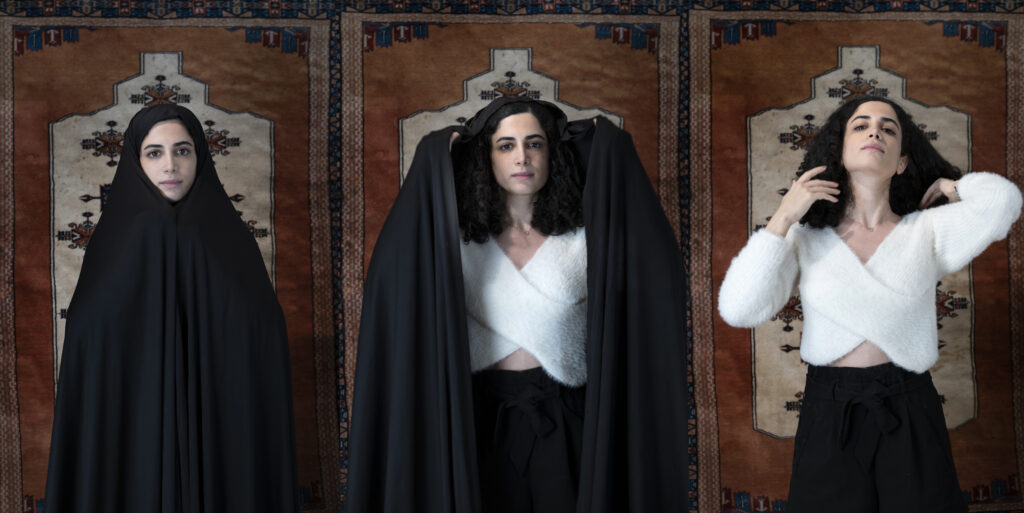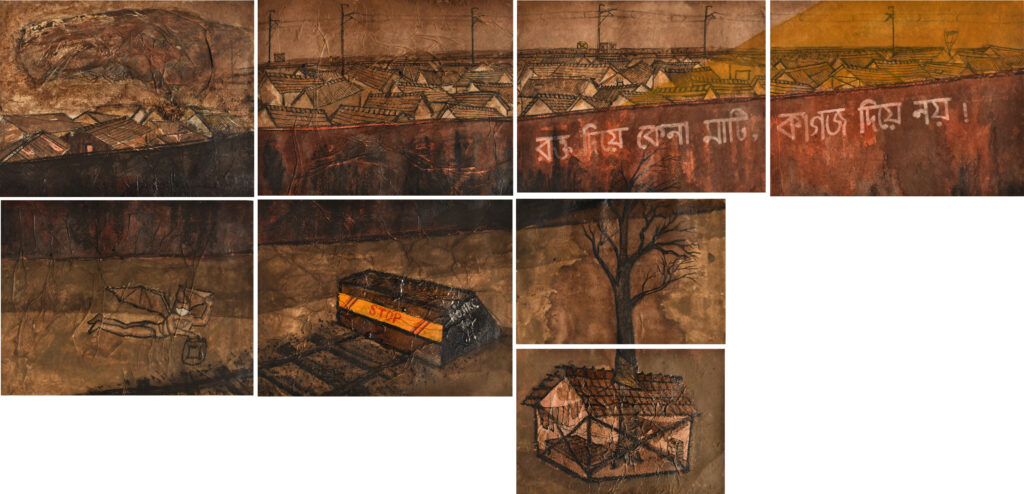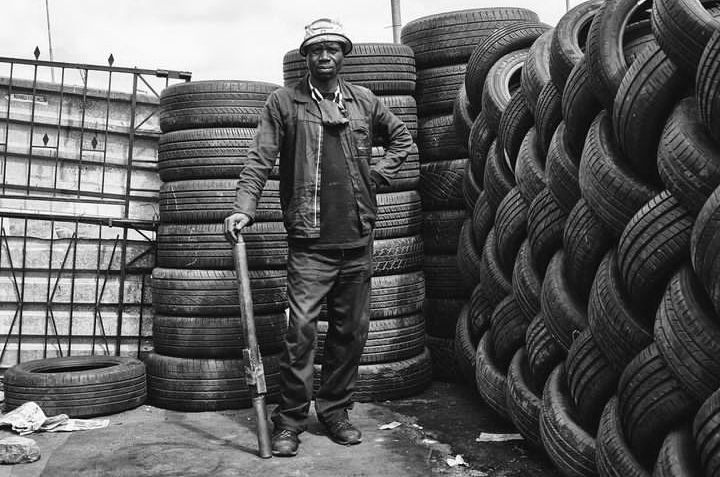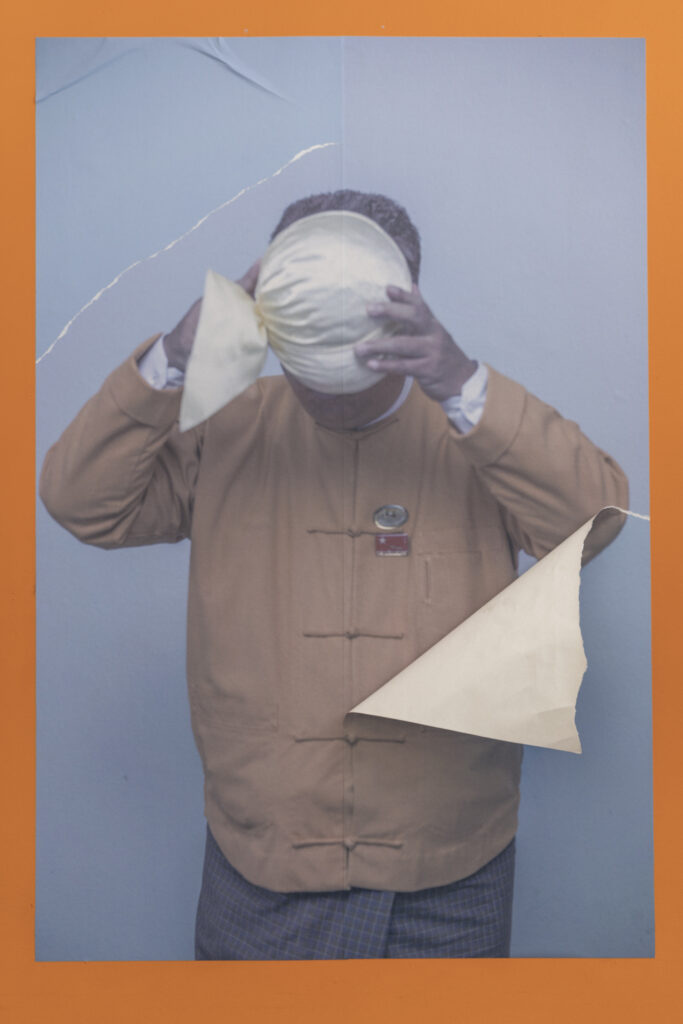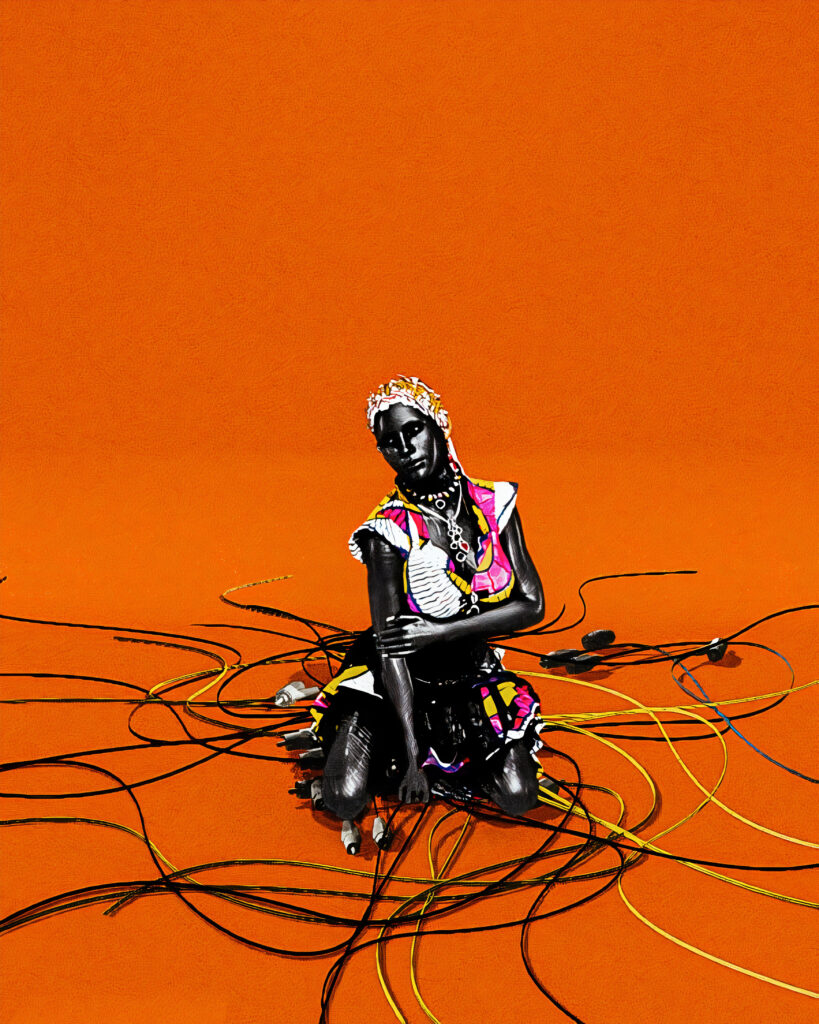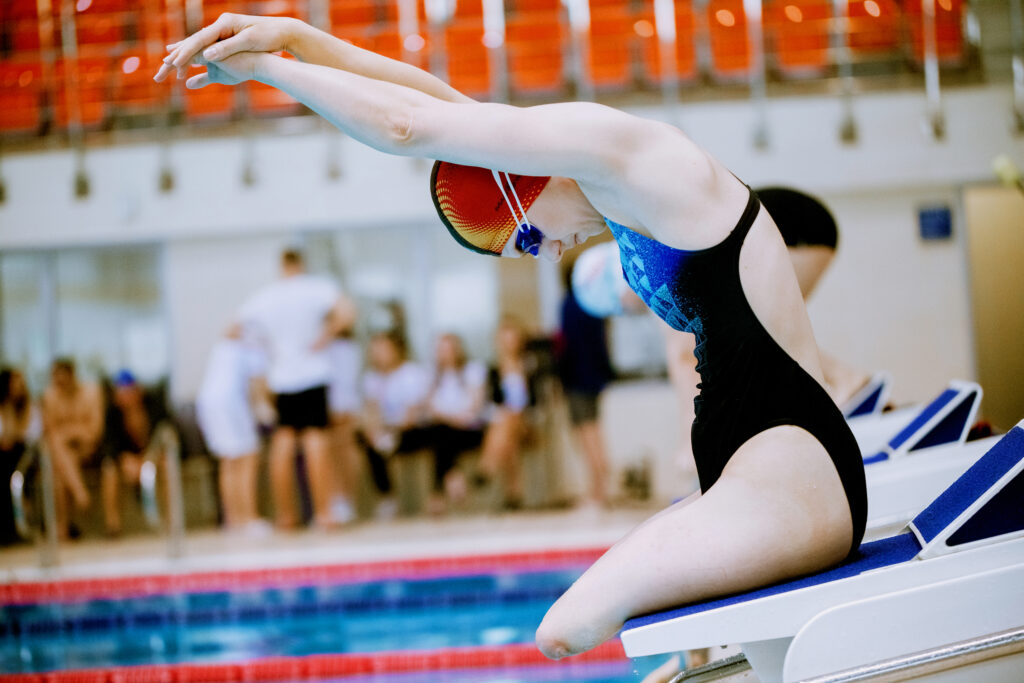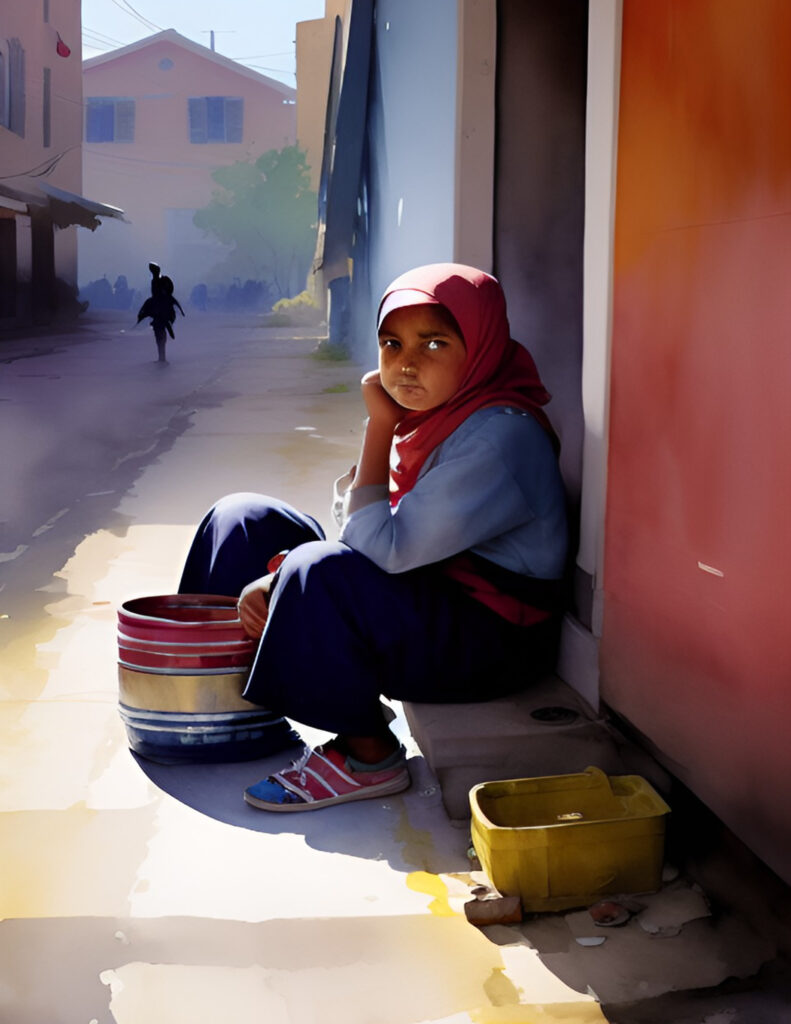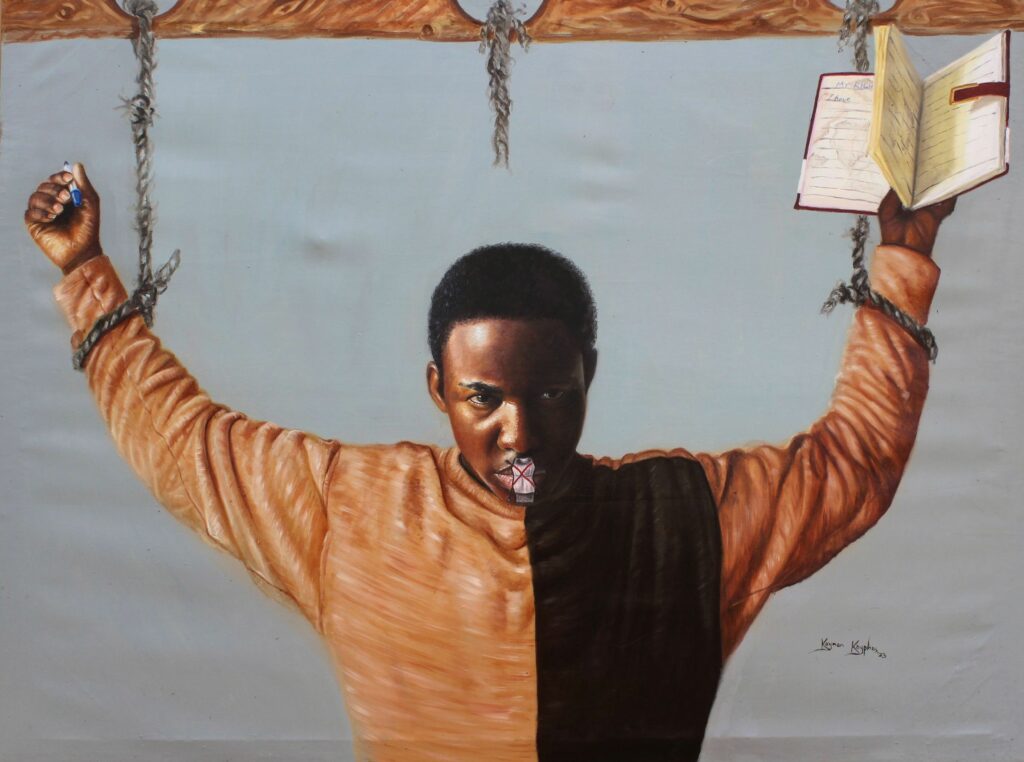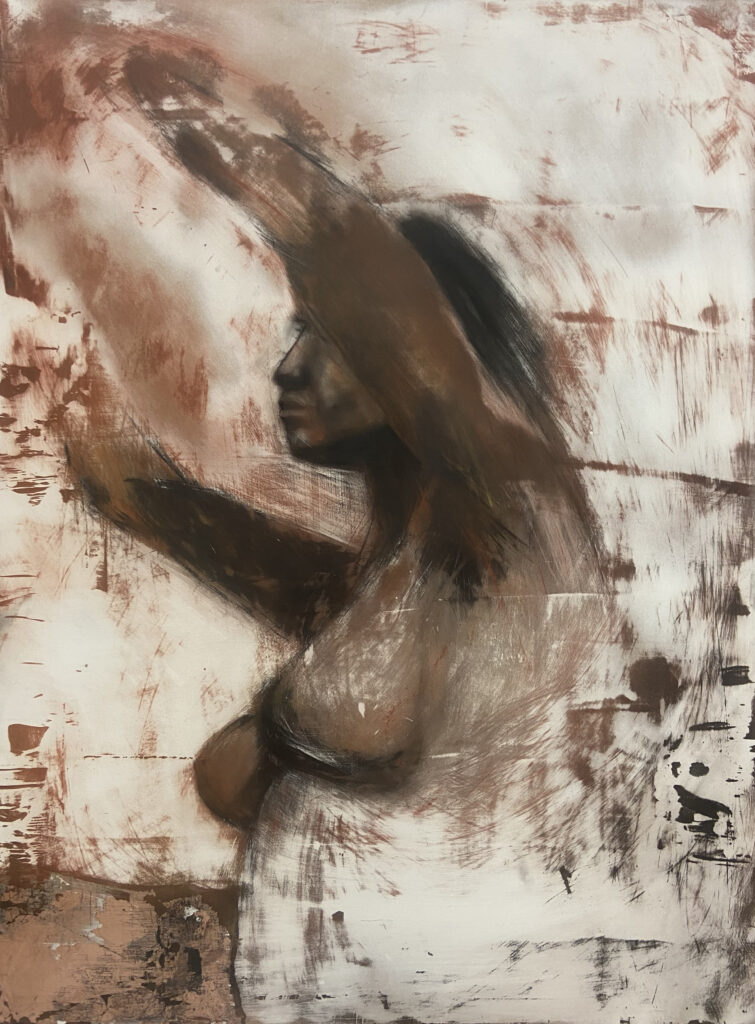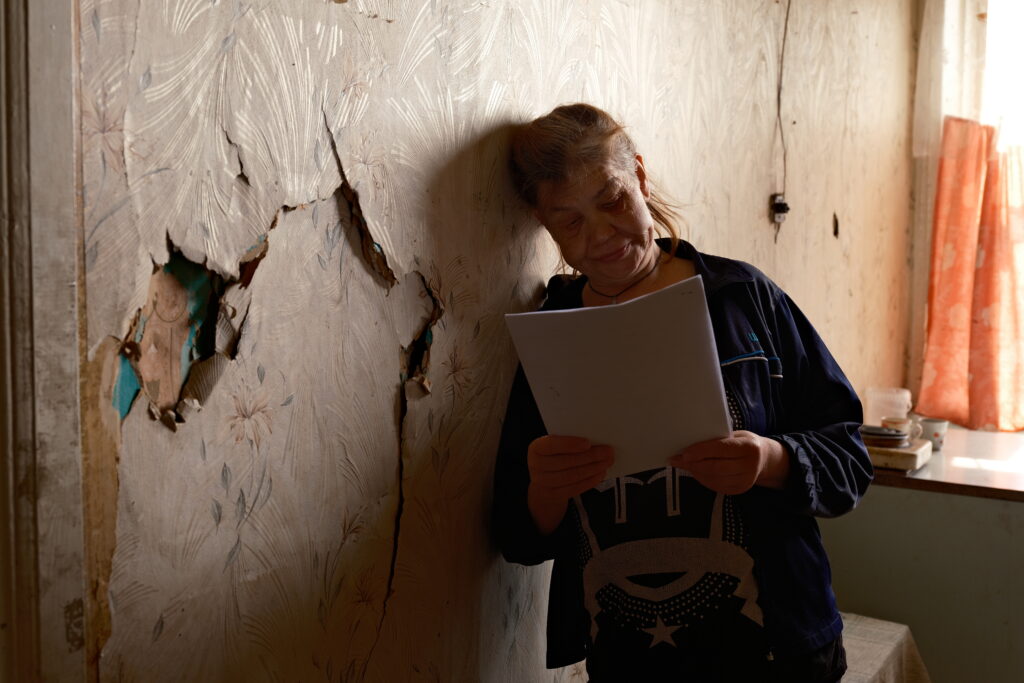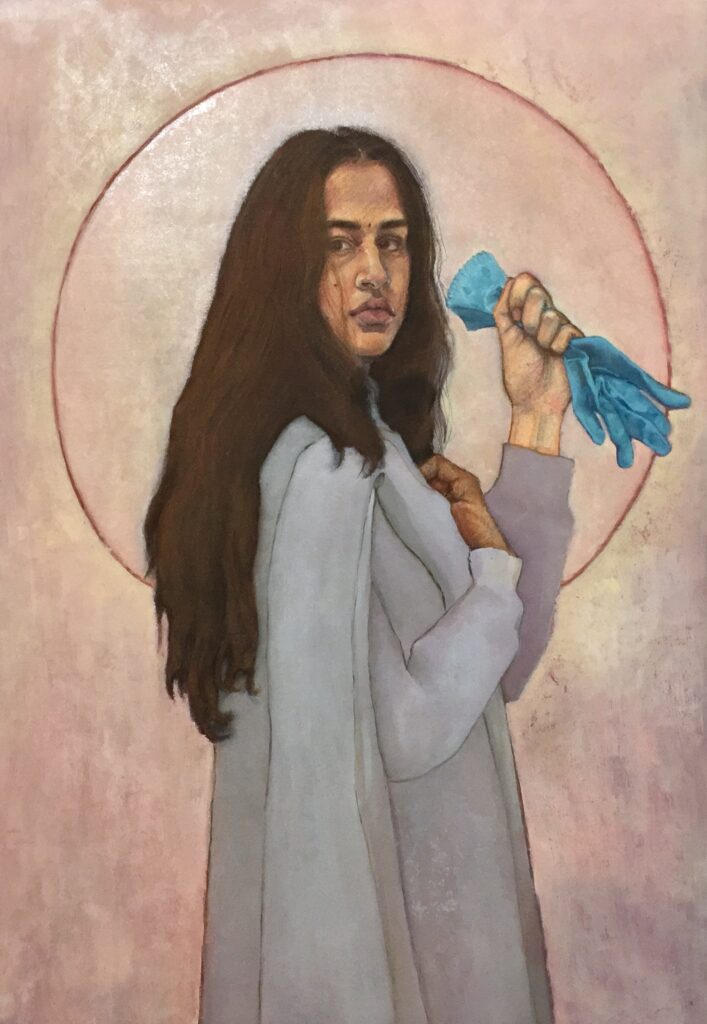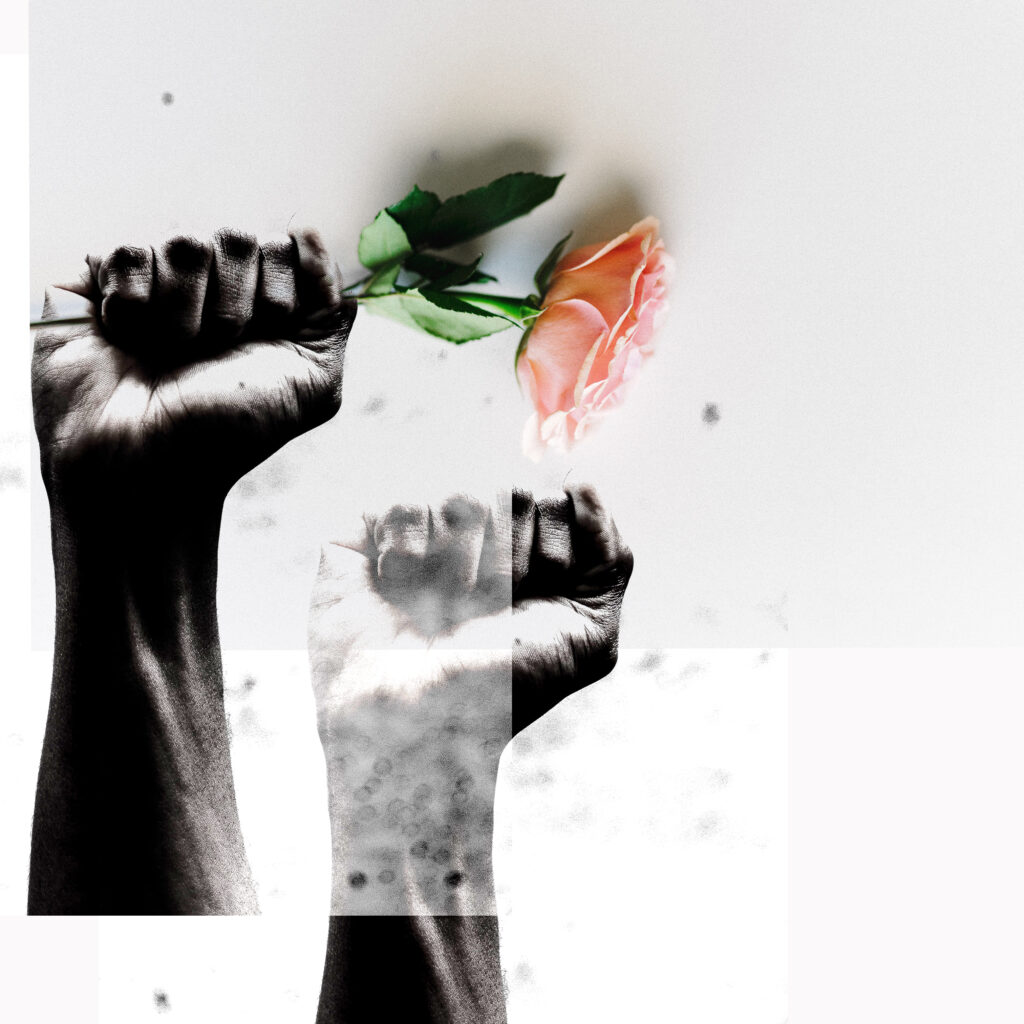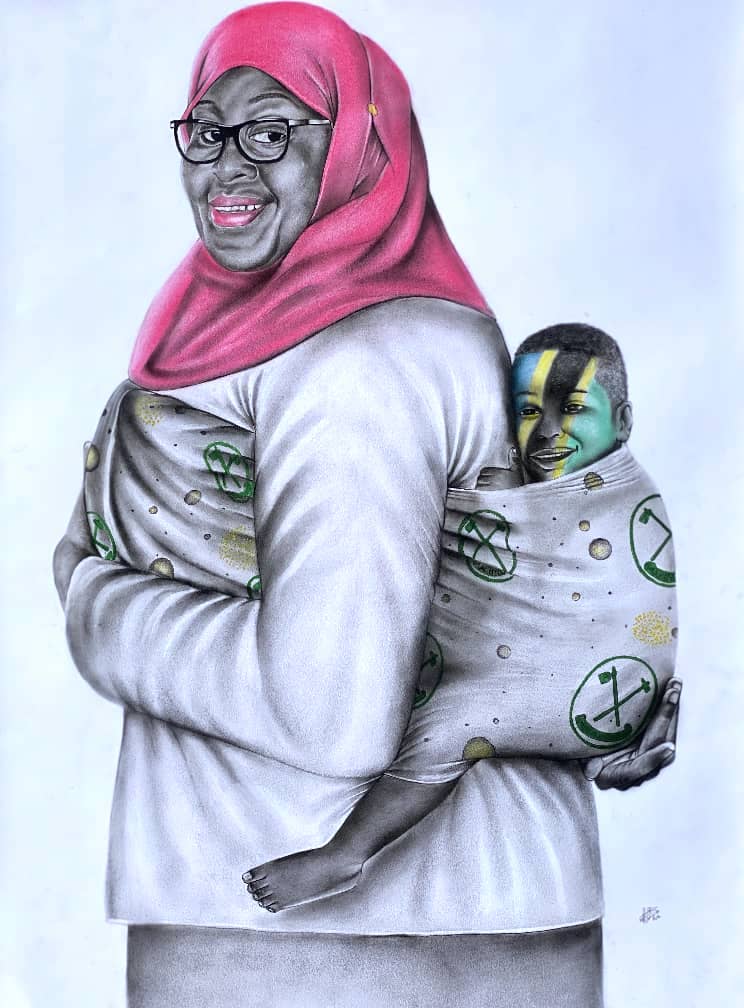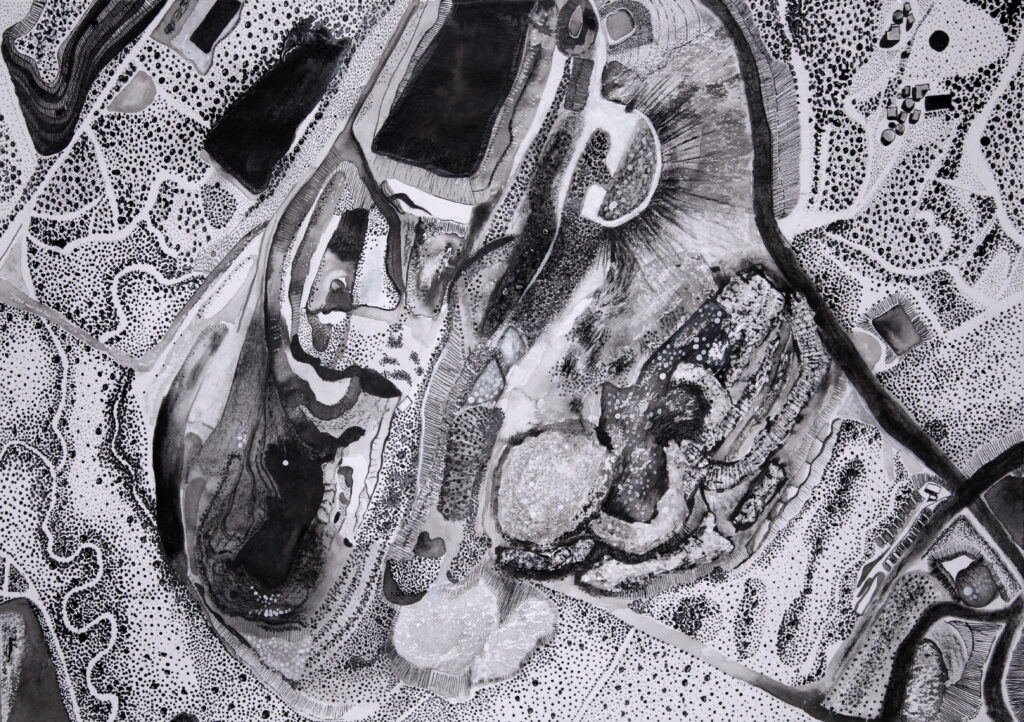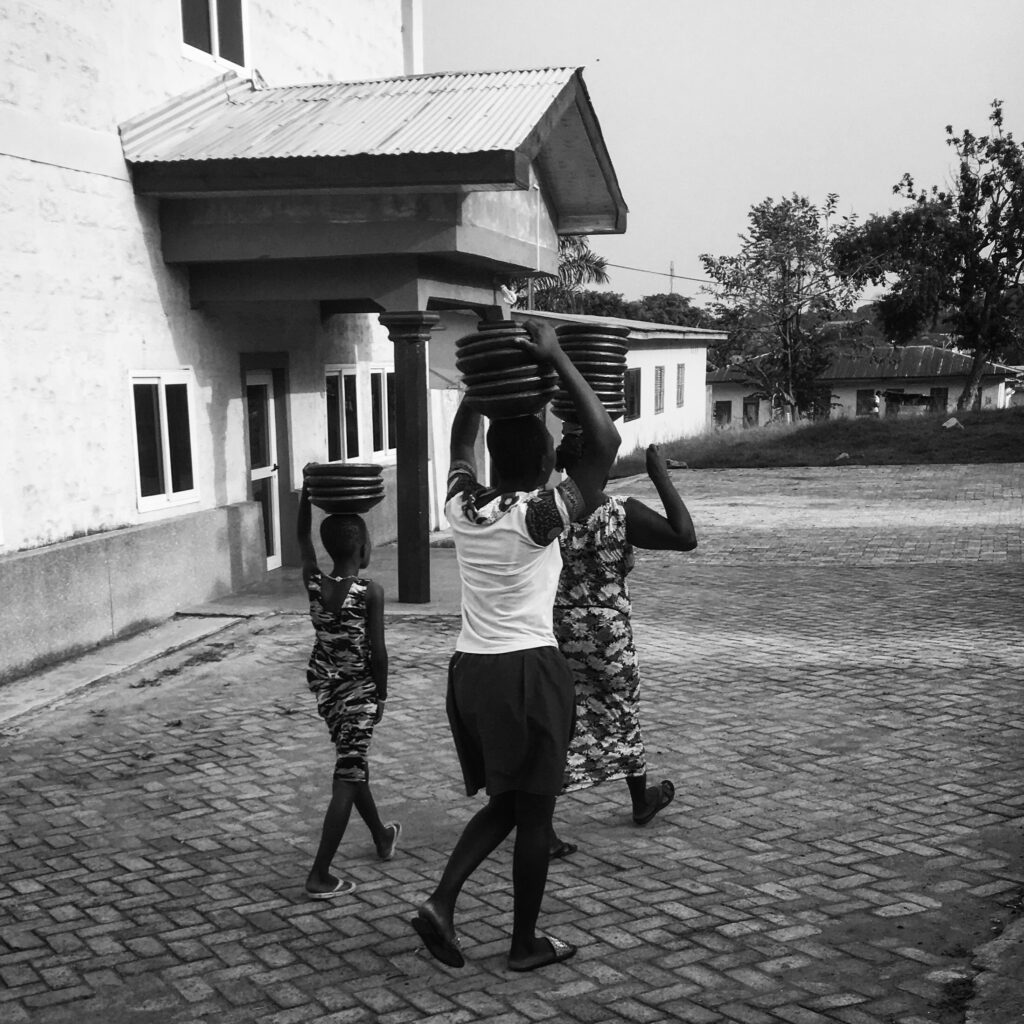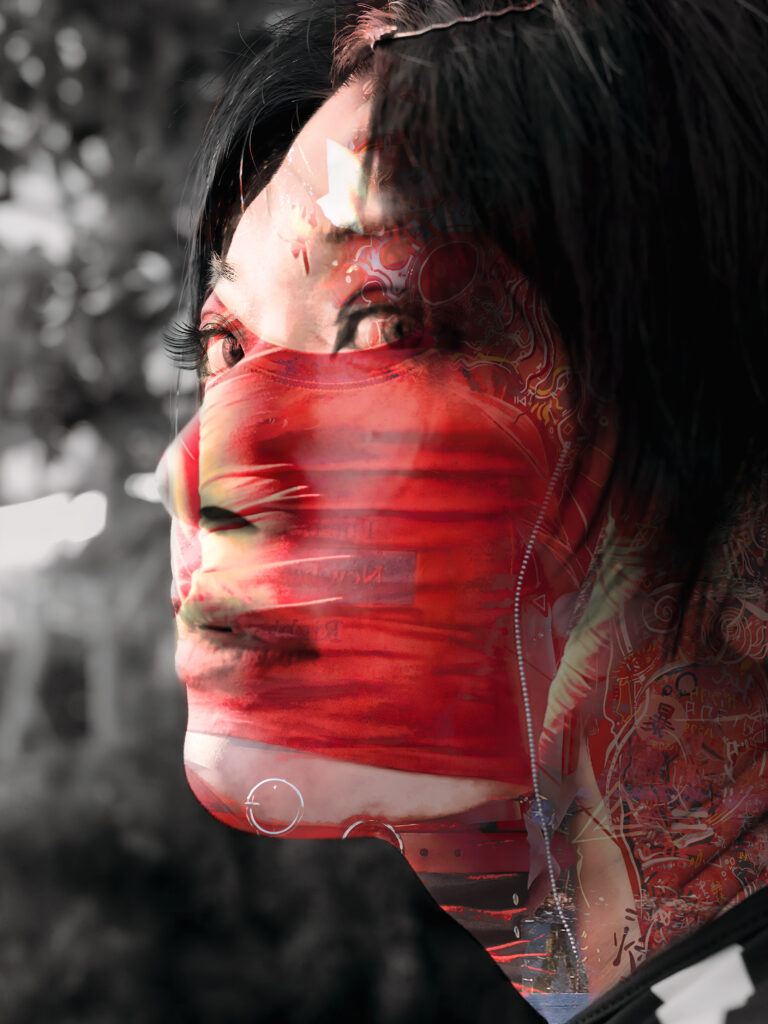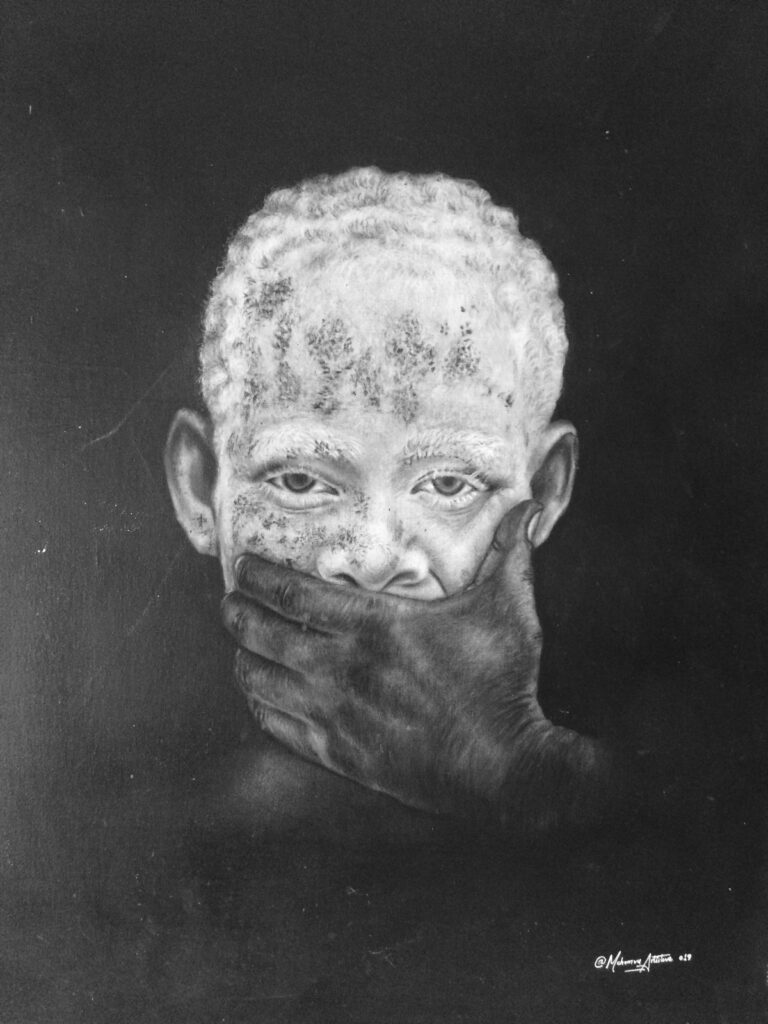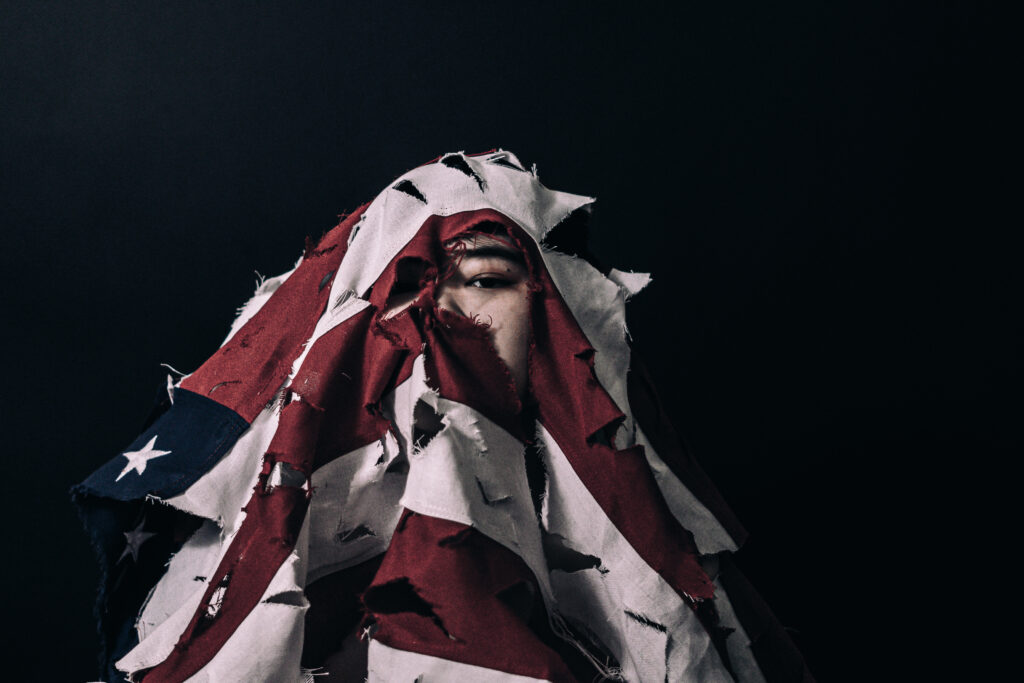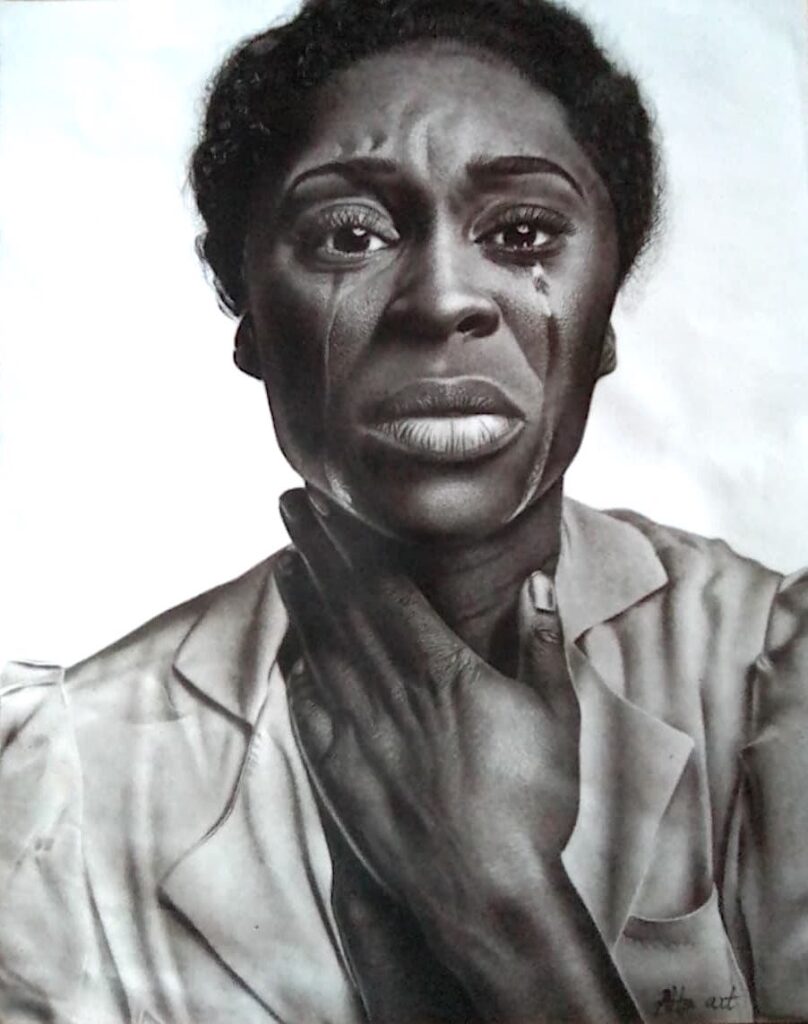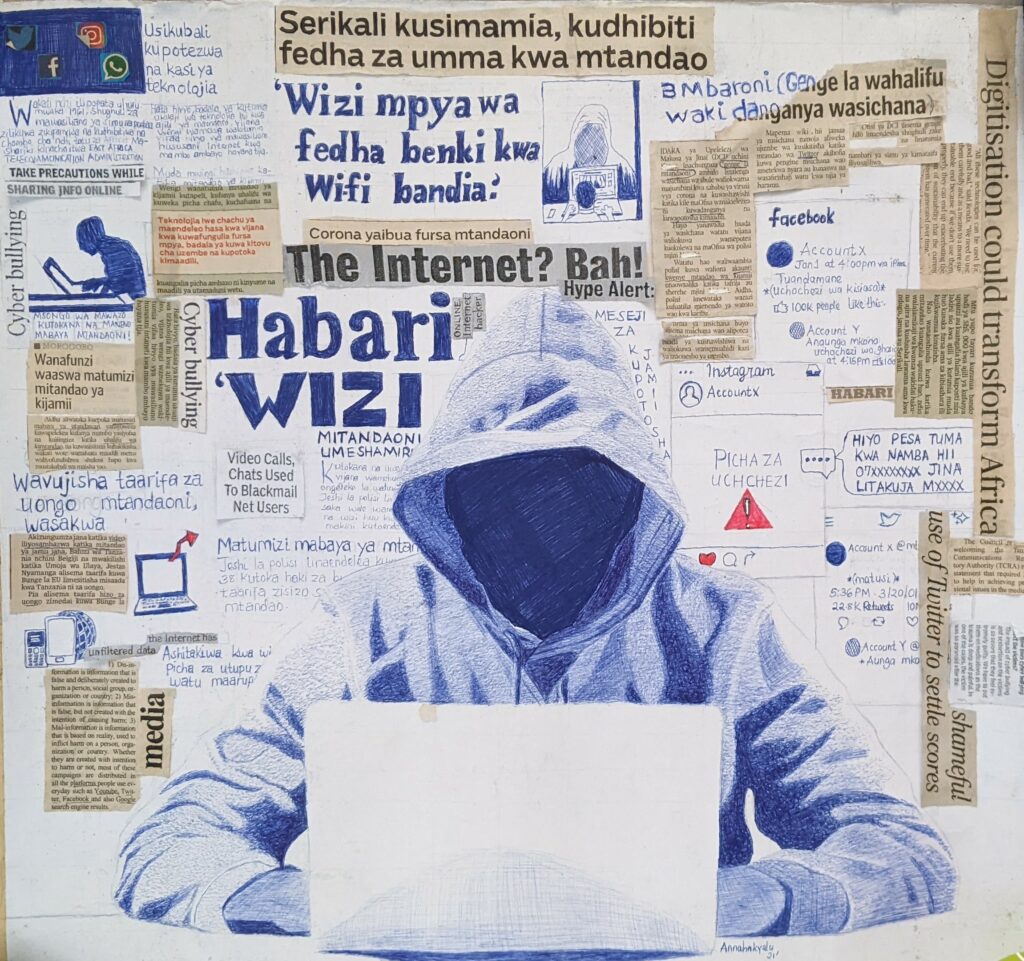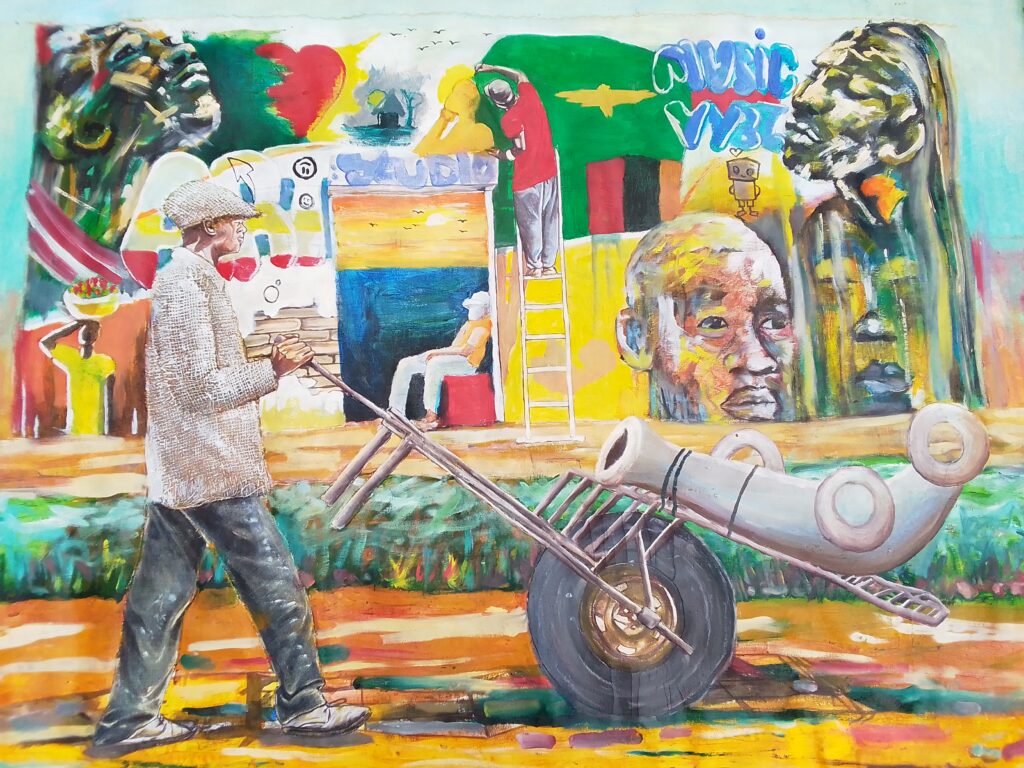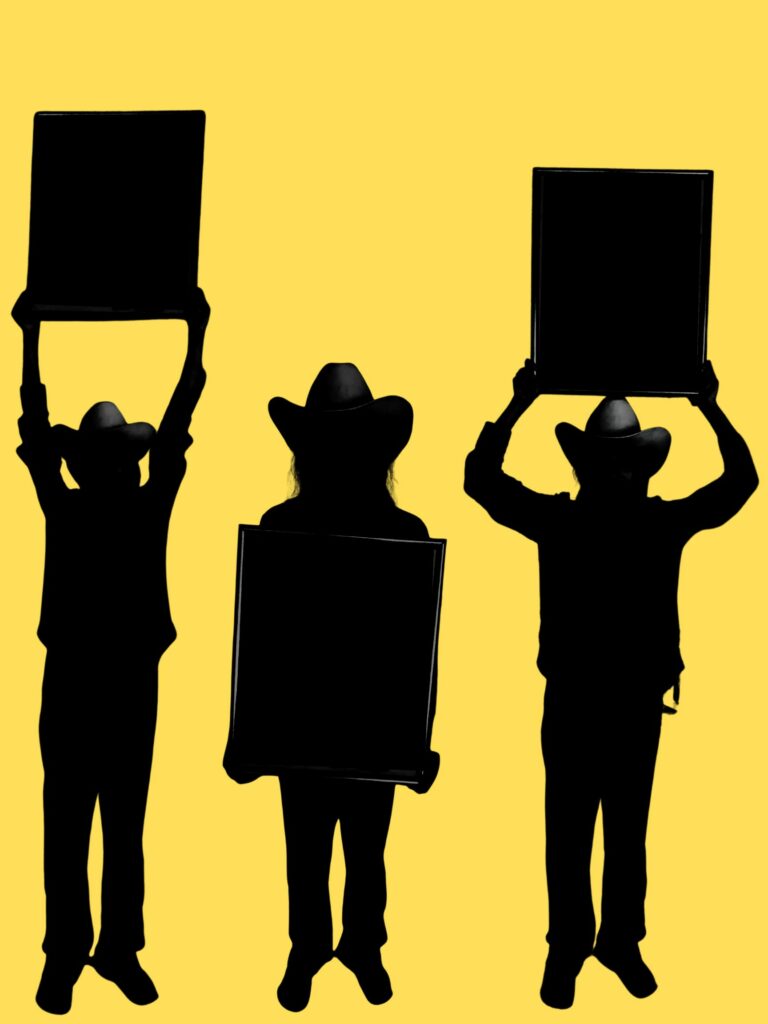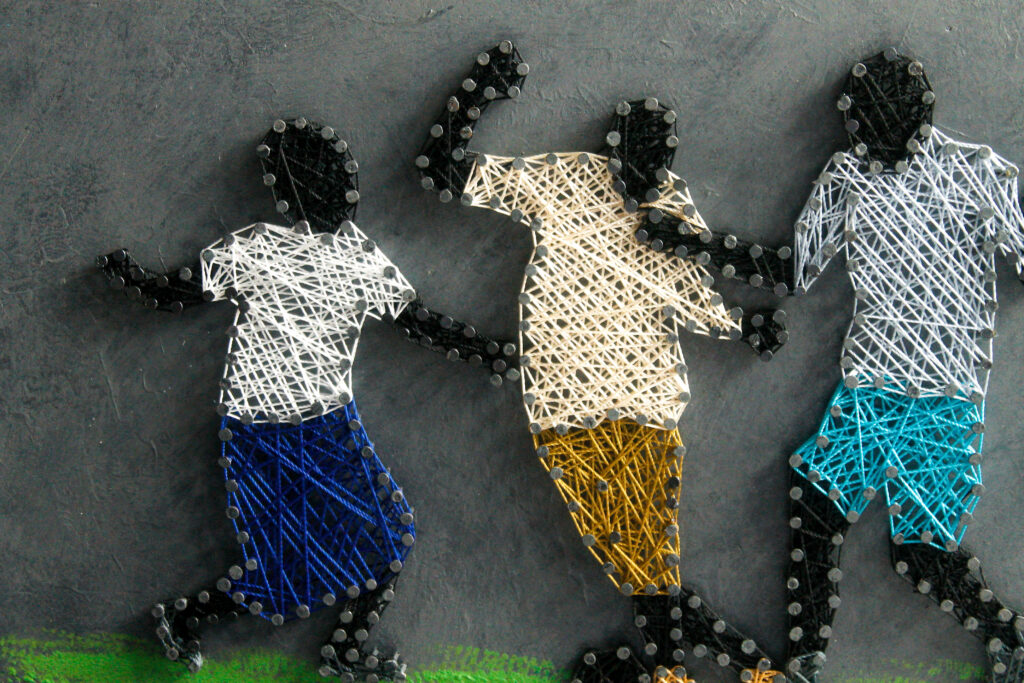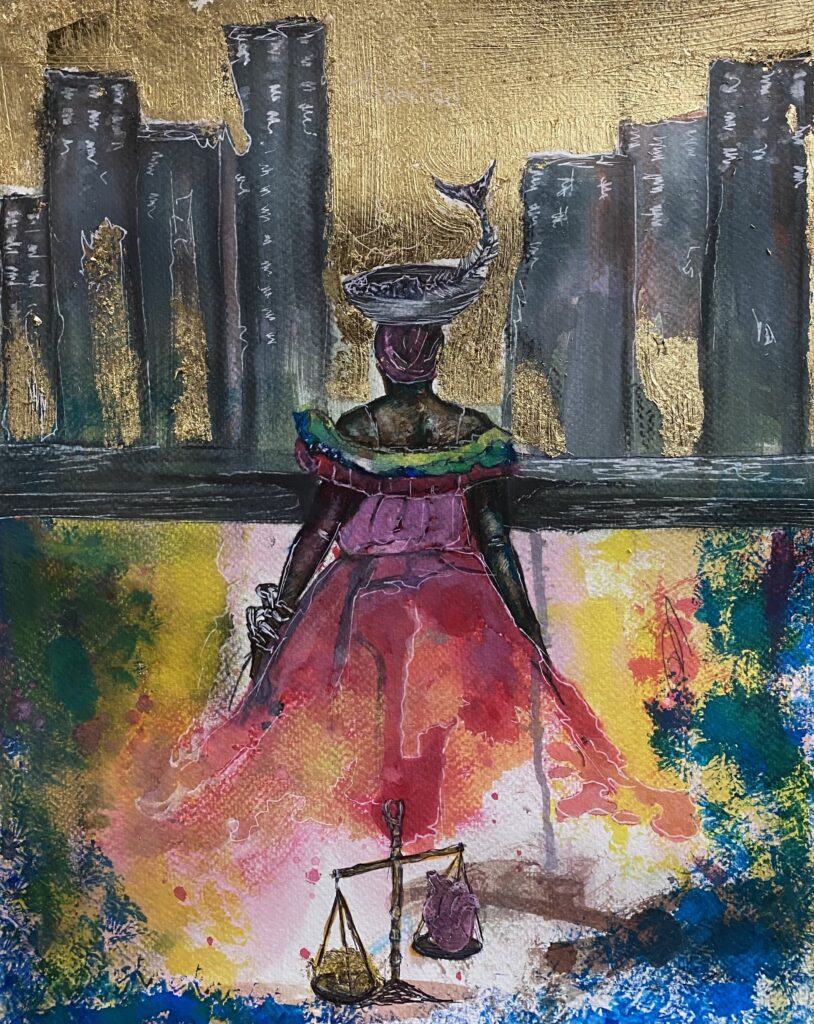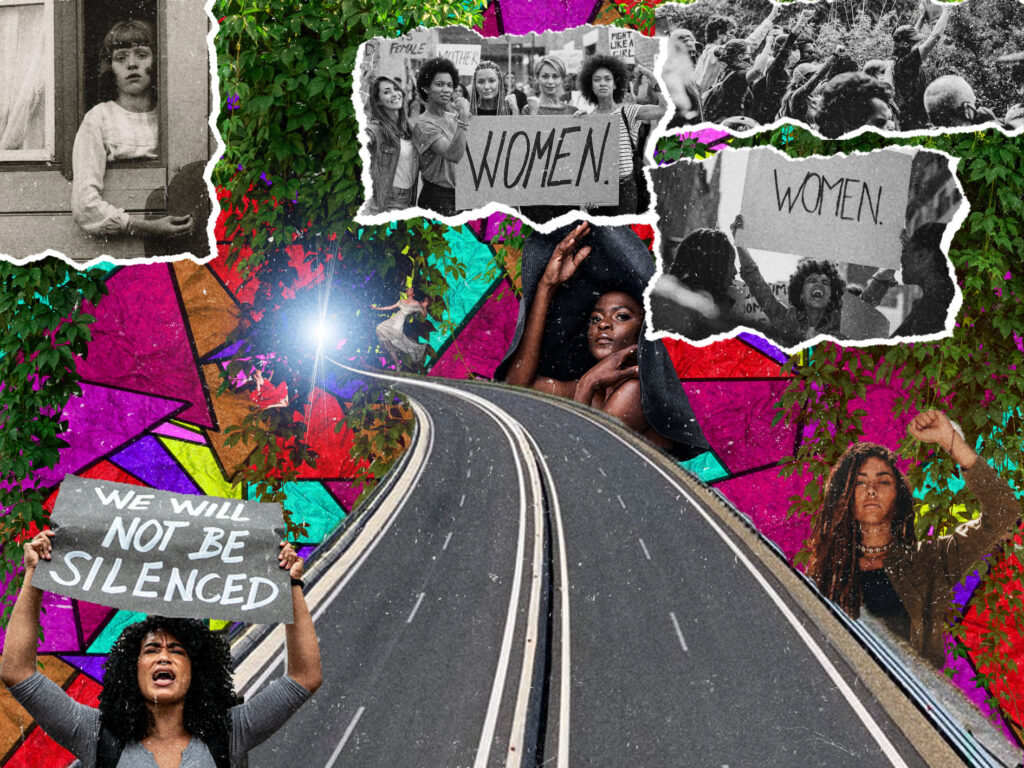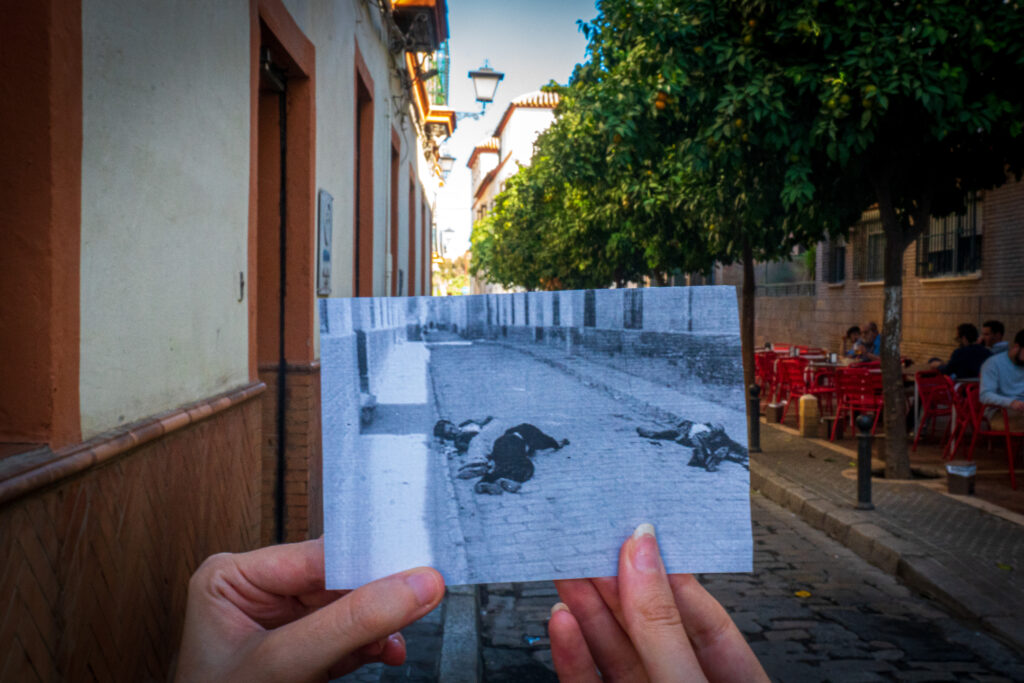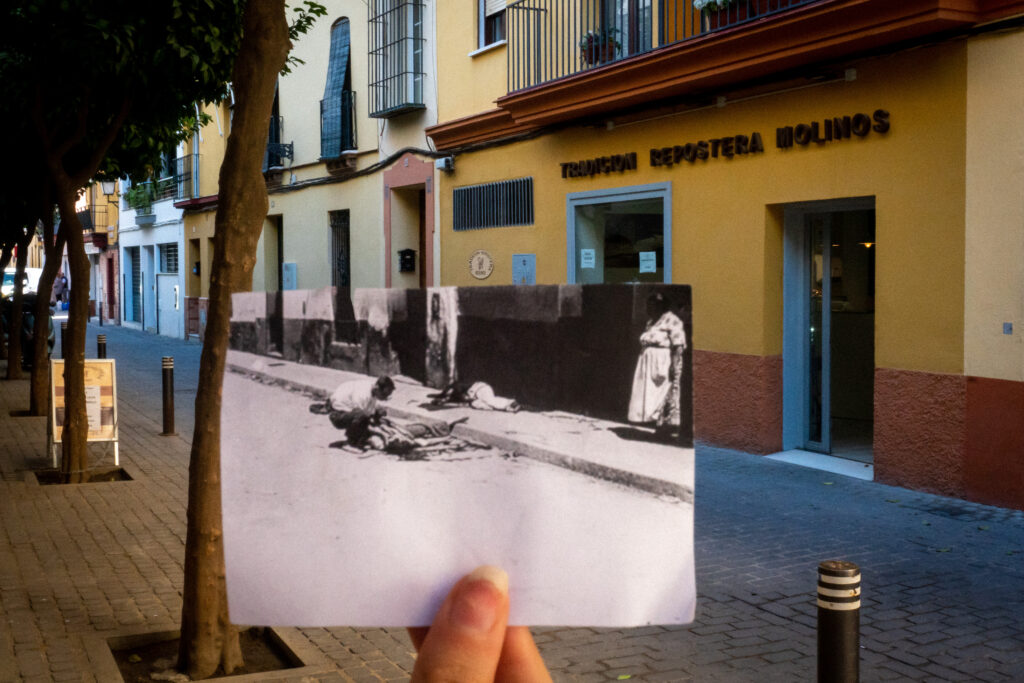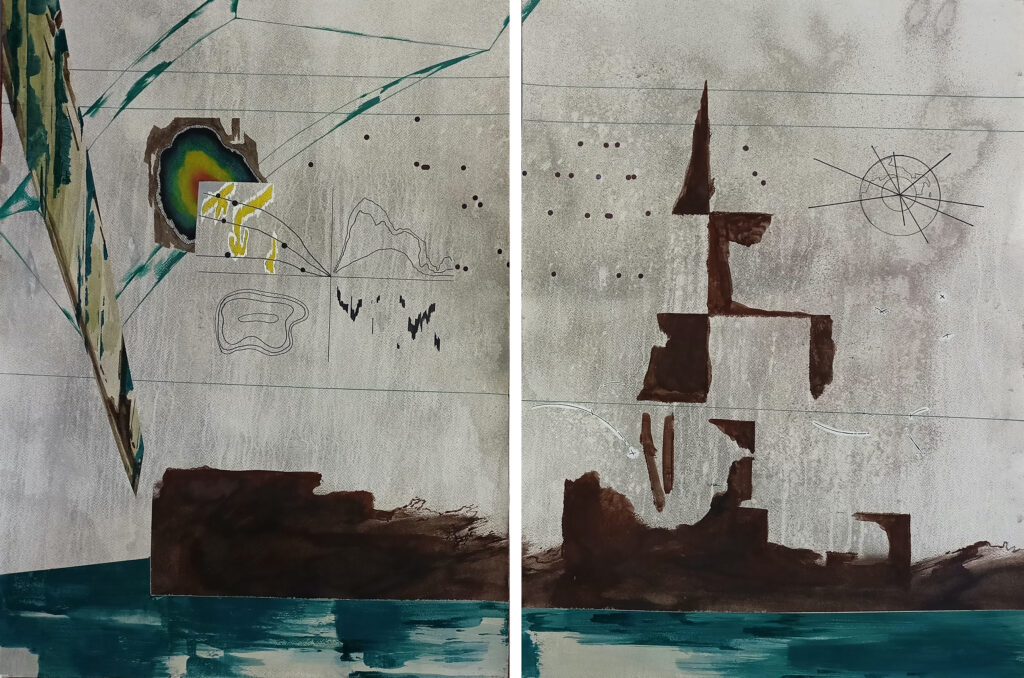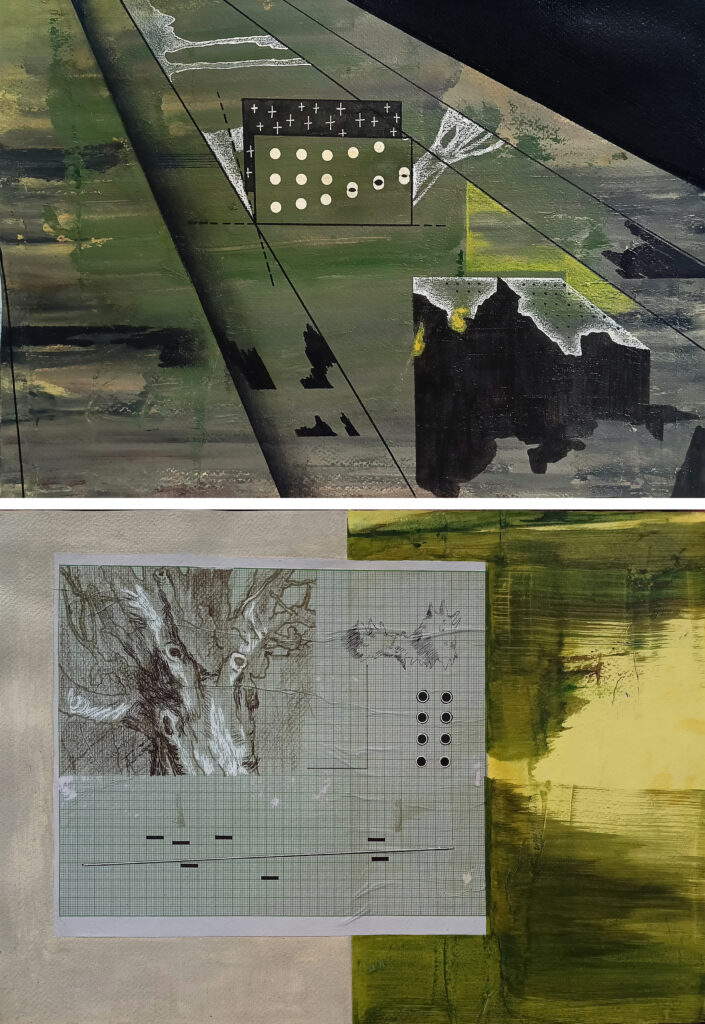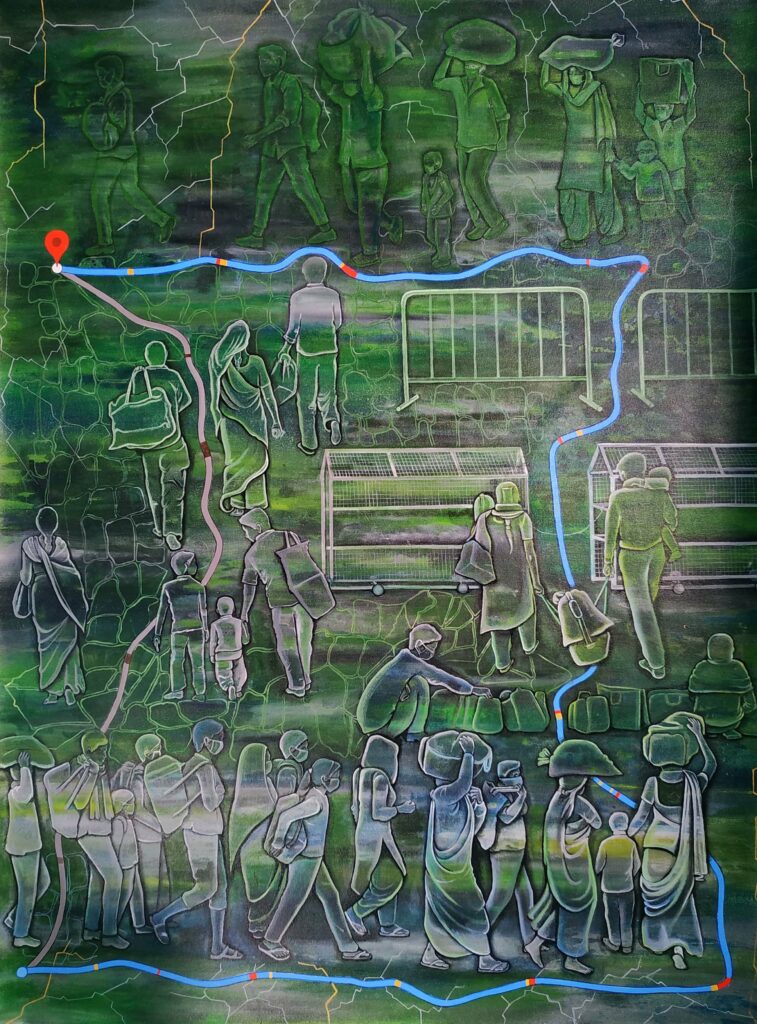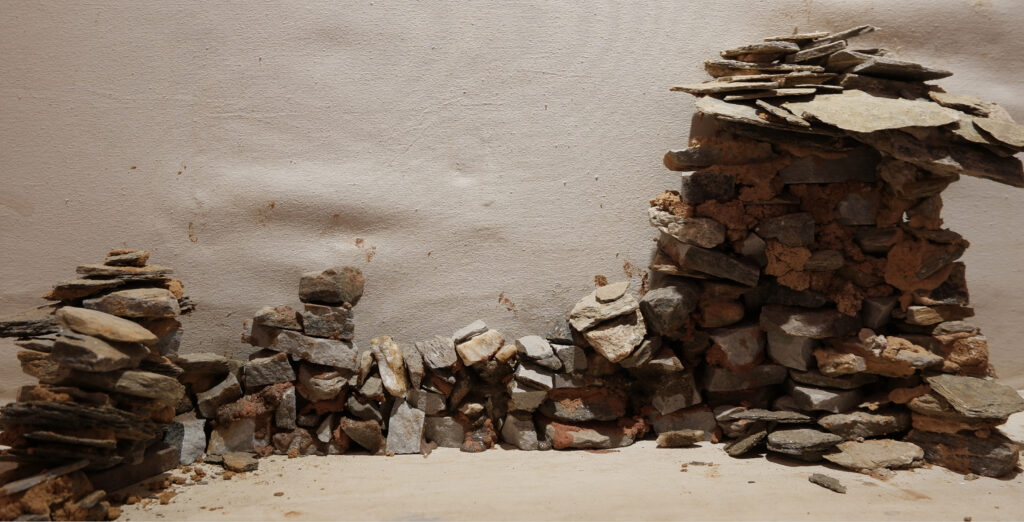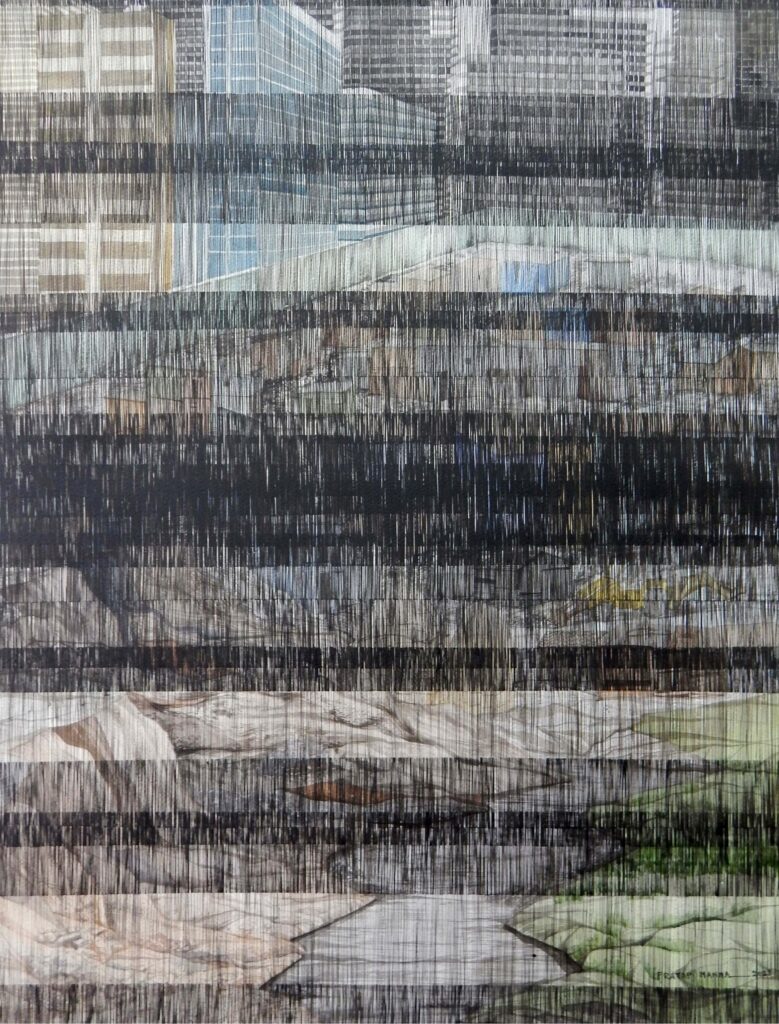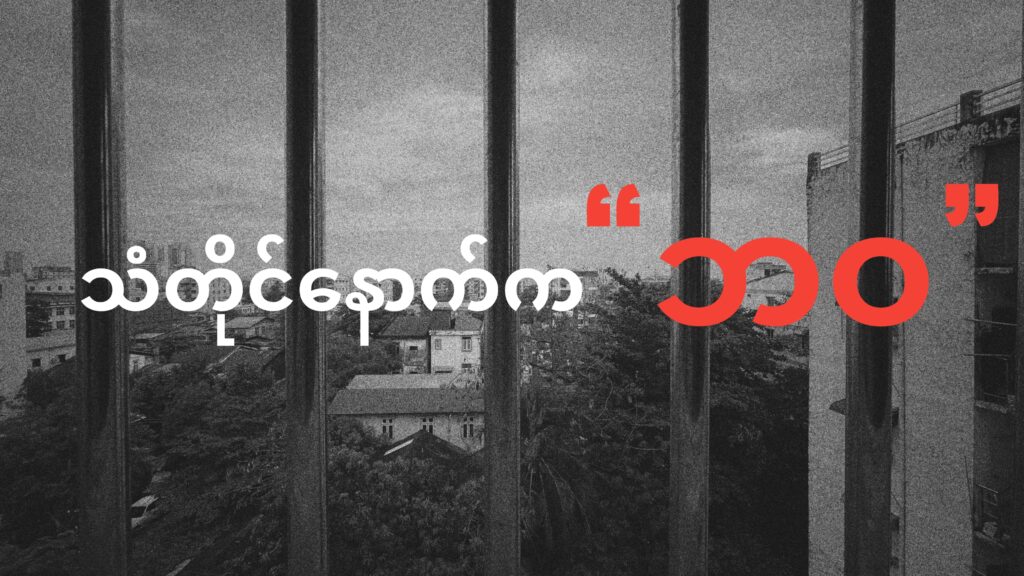‘Art & Human Rights’ | 2023
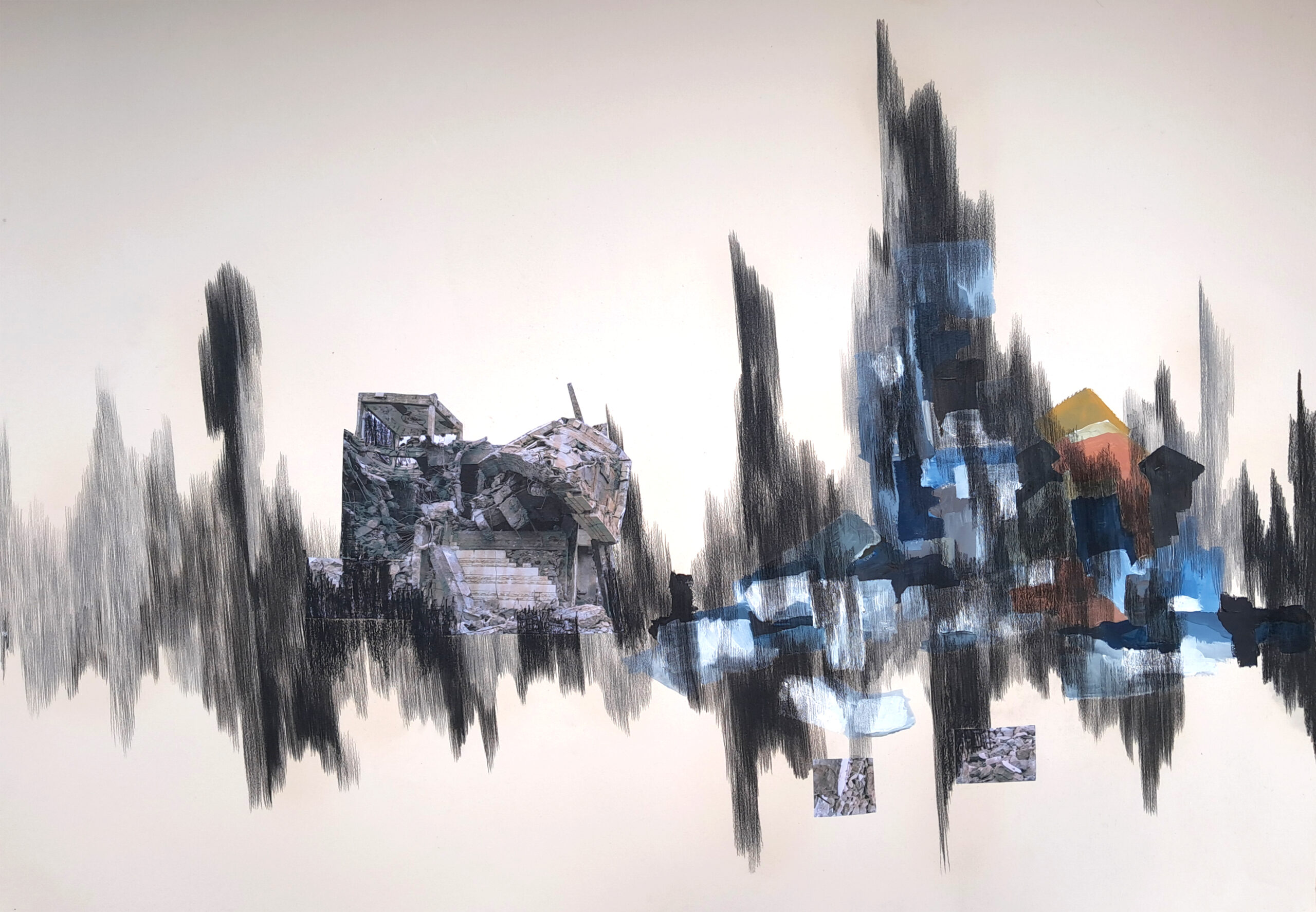
International Emerging Artists Exhibition
We are pleased to present 'Art & Human Rights', an exhibition of 40 young artists' works from 18 countries around the globe, addressing human rights issues and concerns. The exhibition encompasses an array of visual media including a video performance, along with photographs, drawings, paintings, and mixed media pieces.
The idea for this exhibition grew out of an online international symposium focused on human rights, organized and developed by the Human Rights Research and Education Centre (HRREC) at the University of Ottawa, Canada. Seventeen of the works shown here will be on view at the University of Concordia, Montreal, as part of the multimedia exposition Arts & Human Rights: Conversing Multiplicities, May 30 – June 8, 2023, made possible through the ongoing collaboration with HRREC conference leaders Oonagh E. Fitzgerald and 233 | Ramon Blanco-Barrera.
The response to our Call for works on the theme “Art and Human Rights” showed that recognizing what our rights are as human beings, and how they are often ignored, infringed
upon and violated is an experience shared across cultures and geographic boundaries. Through embodied representations in symbolic, poetic, and abstract visual forms, the artists here engage a wide-ranging span of injustices, inequities, oppressive forces and concerns that include racism, censorship, violence, poverty, marginalized identities, and forced migration, along with environmental displacement and degradation.
While provoking questions, these works raise awareness and inspire action.
-The EAS Team
Click each artwork to enlarge (cell phone users, turn your phone sideways to view the gallery properly)
Anirban Mishra | Tamluk, West Bengal, India
3rd Place Award Winner
Death of Heroes | Mixed media on paper
Children need a good education to grow and contribute to our society; however, many children are treated as labour. From childhood, they break bricks or work as laborers, instead of getting an education which is their human right. As an artist, I have always wanted to speak against child labour. The facial expressions of these children show that they are tired. They are holding books in their hands to represent that they want an education, have big dreams, and want to live a good life. On the right side of the painting, some children are being attacked by persons in authority. It is violence against child laborers.
Nischay Thakur | New Delhi, Delhi, India
Candle March | Terracotta and candle
A flame holds the suppressed elements of oxygen that are ready to inflate and produce light for others to see beyond or to have better things to eat. The candle metaphor is used to represent the phenomenon of people taking action against injustice to individuals or groups whose rights have been stripped away. To protest social evil, we humans take up the flame to inflate our hope for a better future, or to eradicate practices that hinder our rights. This work is a classical and symbolic reference to those times when humans have come together and stood up against injustices.
Aydin Matlabi | Montreal, Quebec, Canada
As The Wind Blows: Mahsa Becomes the Wind | Digital fine art print
“As The Wind Blows” is a fine arts photographic project that aims to use the power of portrait photography to highlight the stories of Iranian women’s liberation and their continual revolution. The act of taking off the veil is a powerful symbol of liberation from social and cultural restraints imposed on Iranian women.
Suvojit Roy | Kolkata, West Bengal, India
Surjer Moto Purte Pari (I Can Burn Like the Sun) | Coffee, tea, charcoal, Nepali handmade, phenyl, soil, watercolour, ink on paper
My work explores different narratives of resistance – socio-political history and migration, NRC (National Registry of Citizens, whose purpose is to document the legal citizens of India so that illegal immigrants can be identified and deported), and their impact on our cultural practices. It reveals life through the lens of ‘otherness’ in one’s own country. I see my work as an attempt to negotiate space with a political and cultural agenda that deems the people living in my social condition as illegal.
Gugulethu Ndlalani | Johannesburg, Gauteng, South Africa
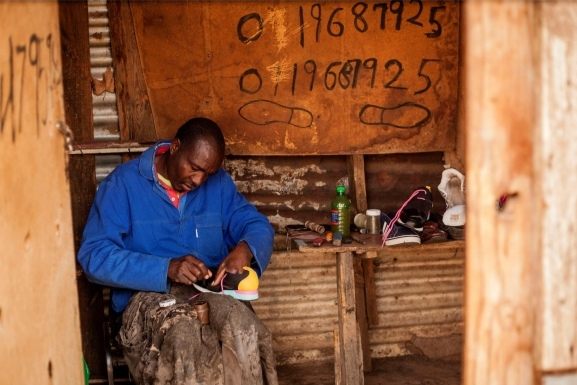
Small Businesses | Photograph
This work is part of the Broken Villages project called “The Art of Survival”. It is based on five local residents from Nancefield Hostel, a small town in Soweto, Johannesburg. Local people decided to start businesses as a way to help the community, seeing that most people are struggling to make ends meet and survive through the day.
Sai ▇▇▇ | Yangon, Myanmar
Father’s Portrait from 'Trails of Absence' Project | Wallpaper installation
In August 2020, my father asked me to take a photo of him for the upcoming election in November 2020.
Among the series of photographs, this one foretold the ominous future. On the 1st of February 2021, I went into hiding for 244 days. On that day Myanmar was seized in a military coup. The country’s de facto Head of State, Aung San Suu Kyi, as well as other senior figures from the National League for Democracy (NLD) and regional government leaders, were arrested in early morning raids. My father, a National League for Democracy member and one of the 14 Chief Ministers in Myanmar was one of those taken. After 165 days of my father being interrogated, tortured, and held hostage inside an unknown military compound, on the evening of July 16th, 2022, he was transferred to a Covid infested prison on bogus charges by the regime, facing a sentence of more than 20 years.
See EAS feature story - Trails of Absence project
Nana Kwadwo Tweneboa-Kodua / Nk | Accra, Ghana
Unleashed by Technology | Digital art
This piece is meant to put forward the message of empowering the African woman with the technology that surrounds her. The idea for this piece was mainly Afro-Futurism, in the sense that women in technology are real agents of change. They can contribute massively to development by providing solutions and new perspectives to existing challenges.
Mikhail Kapychka | Mogilev, Belarus
Championship | Photograph
International Swimming Championship among athletes with disabilities, Minsk, Belarus, is a positive endorsement for human rights. Athletes from six countries: Belarus, Turkey, Ukraine, Lithuania, Azerbaijan, and Moldova took part in the 2019 international swimming championships in the city of Minsk, Belarus. This two-day event, which ran from 16-17 March, was attended by men and women of all ages who have a range of impairments, from limited vision to limb deficiency. About 100 people took part in the heats.
The athletes displayed such fortitude, and it was thrilling to see them achieving such amazing results. Every year the event attracts more and more fans and athletes from around the world.
Helena Barbagelata | Barcelona, Spain
The Long Road Home III | Acrylic and gouache on canvas
“The Long Road Home” is a series that gives homage to the lives of refugee women and their children, marked by daily resistance and strength. From different backgrounds, cultures, and personal histories, these groups may be forced to leave their countries of origin due to war, persecution on grounds of race, religion, nationality, social group, political opinions, or because of serious and widespread violations of human rights. Women and girls whose portraits are the painted history of fortitude.
Kenan Peter | Abuja, FCT, Nigeria
Silenced Words | Oil on canvas
In this painting, a young boy is depicted with both hands spread outwards, holding a book in his left hand and a pen in his right hand. However, his hands are tied together by a rope, preventing him from freely expressing himself. The most striking aspect of the painting is the boy's sealed lips, which symbolize the silencing of his thoughts and opinions.
The painting represents the importance of freedom of expression and human rights, particularly in education. The boy's hands represent his ability to learn and express his thoughts and ideas, but the rope signifies the obstacles and limitations placed upon him. The sealed lips indicate that he is unable to express himself fully, thus emphasizing the importance of free speech and the ability to have a voice.
"Silenced Words" highlights the right to express oneself and to have access to education without restriction or censorship.
Asiegbu Collins | Nigeria
Ojadili | Metal Sculpture
Ojadili is an Igbo (Nigerian ethnic group) character in a folk tale. The story is about a young warrior who has conquered many battles and gained a lot of respect. Given Ojadili’s personality and character, I am using his sculpture to wonder how we can individually and collectively battle for our rights as humans in our society, with the ultimate goal of peace.
Suvendu Bhandari | Sheoraphuly, West Bengal, India
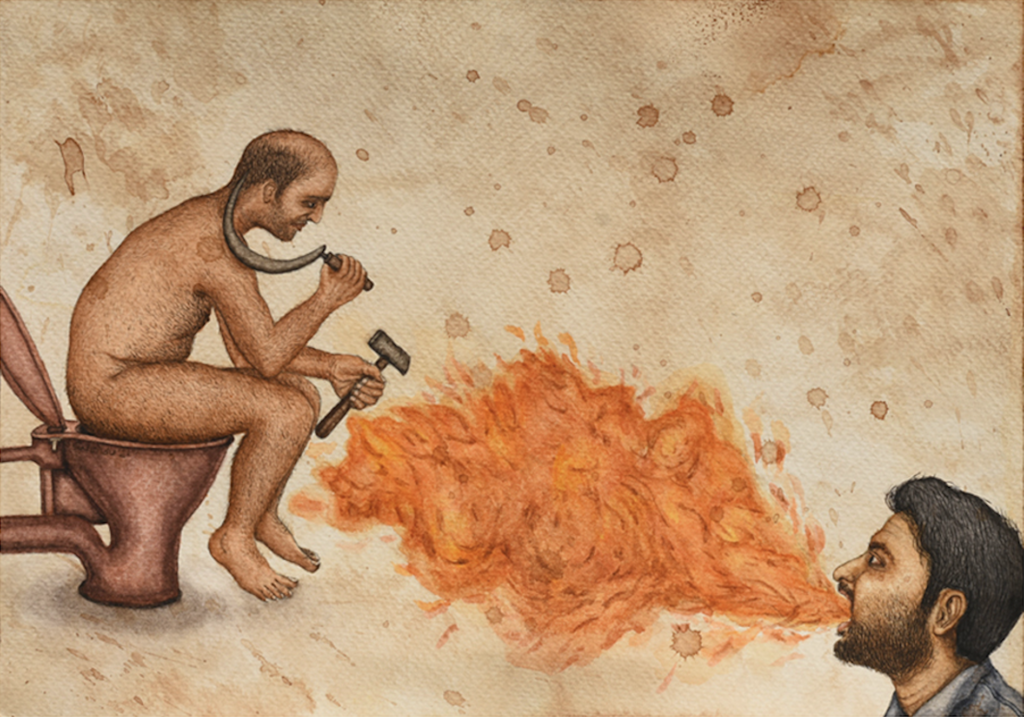
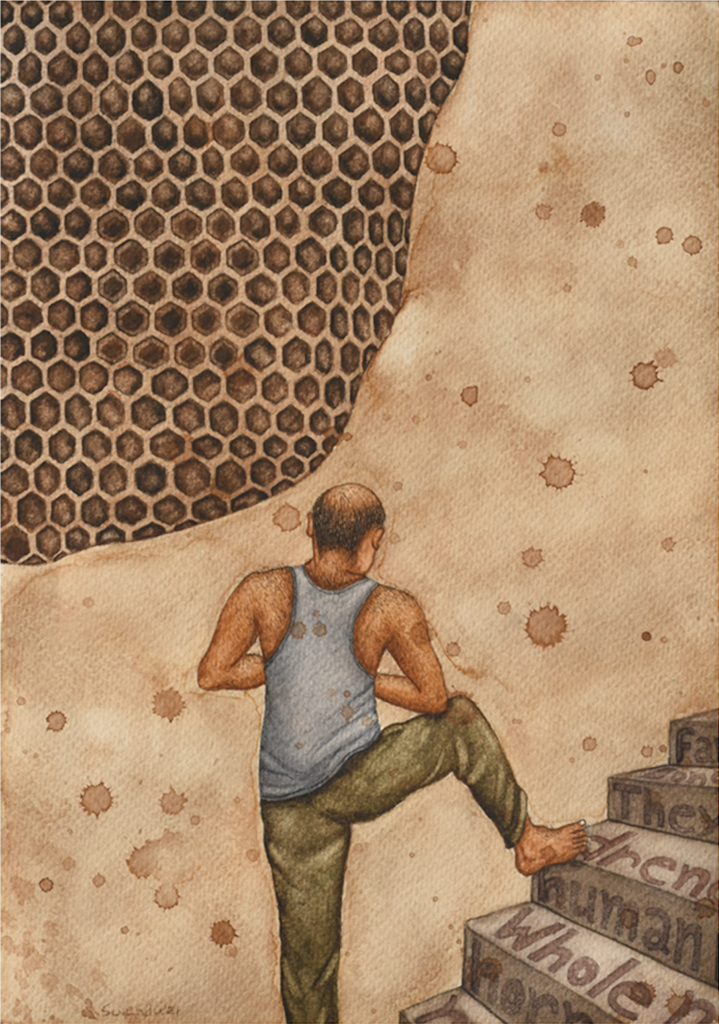

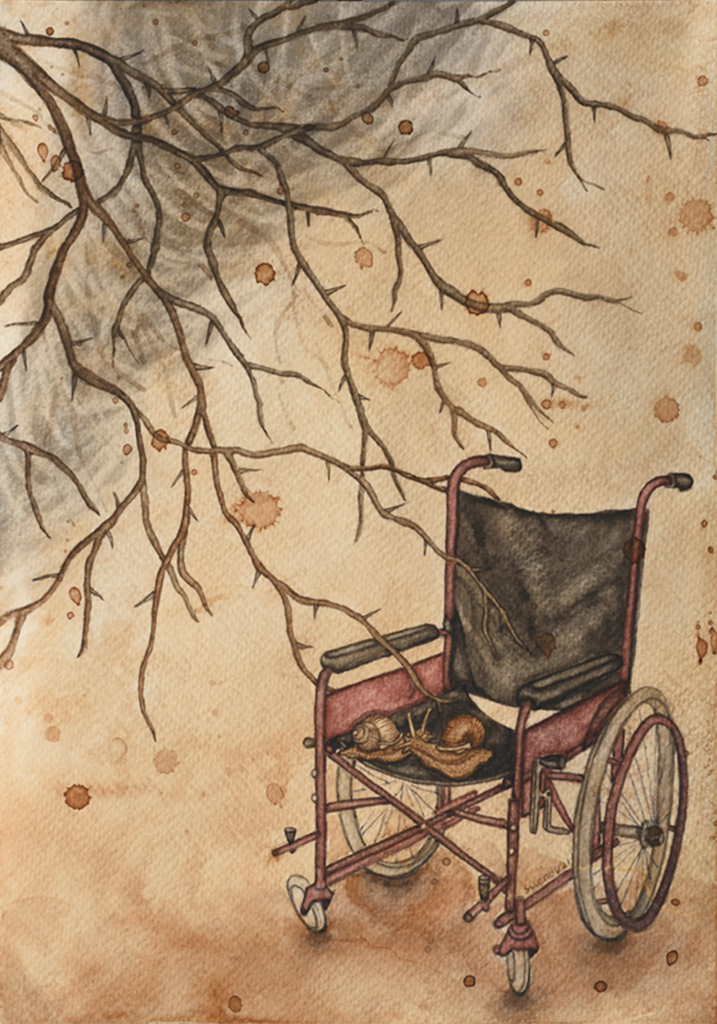
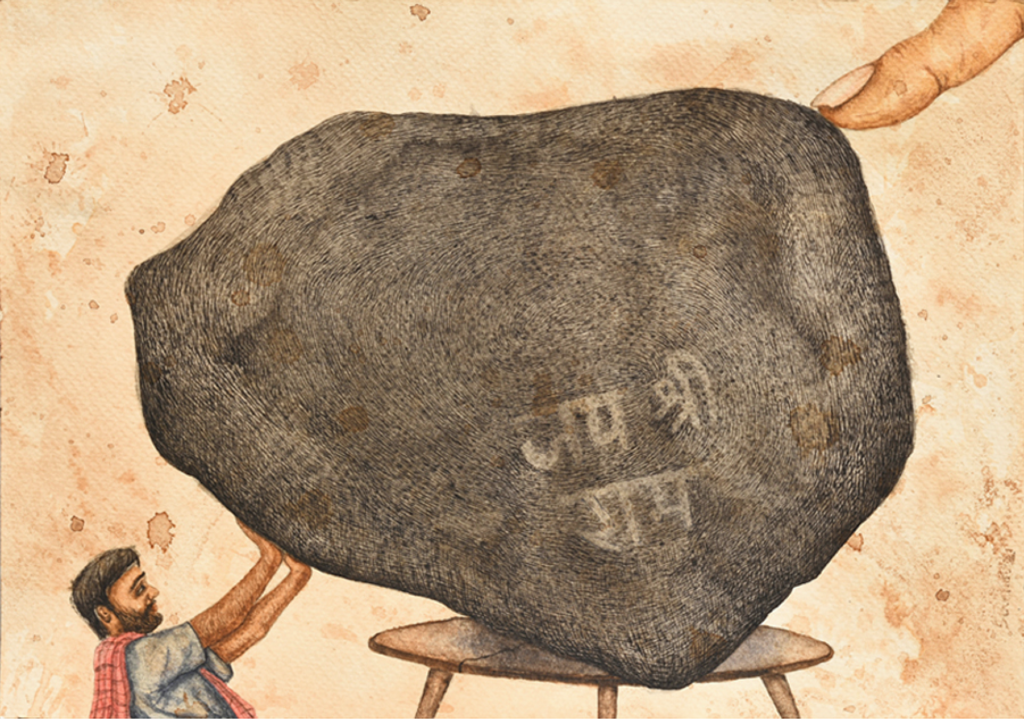
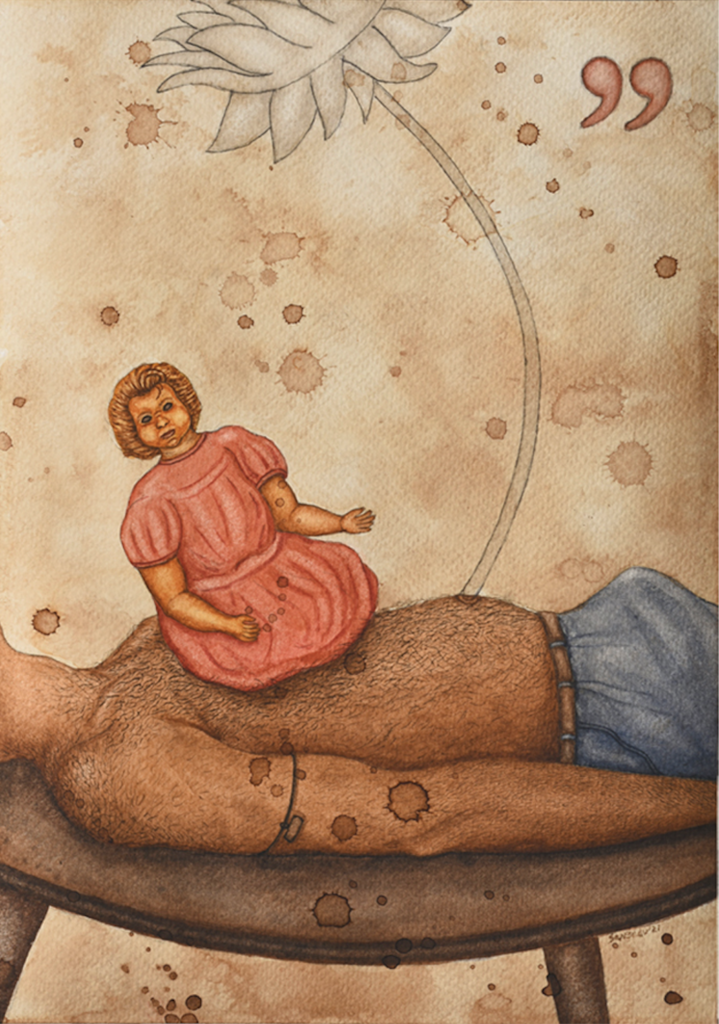
Smoke at the Forehead of All Dreams | Tea strain, watercolour, and smoke
I was deeply affected by the way in which common people consistently fought an unequal battle against nature and political power during the lockdown. The disaster that befell the lives of ordinary working-class people, as a result of the stagnation of time during the pandemic, has emerged as a fragmented, surreal narrative in this painting series, which references politics, child abuse, Indian mythology, the life of daily labourers, daily news and western philosophy. At that time and still, in many countries of the world, many rights of common people have eroded. My weapon against all the injustices is my paintings, they stand by all the common people of the society.
Ángel Castilla Olmedo | San José de la Rinconada, Sevilla, España
No Fear | Plaster, charcoal, pigment, and copper foil on wood
This artwork portrays a powerful image of resistance and resilience against oppression through the depiction of a female Indigenous figure in motion. The use of charcoal drawing, visible tears, and breaks suggest a sense of struggle and fragmentation, while the background of white with jagged red scratches and scrapes creates a feeling of chaos and discord. The copper at the bottom of the painting adds depth and texture, hinting at the richness and complexity of the indigenous culture that the figure represents. The artwork serves as a poignant reminder of the ongoing struggles faced by indigenous communities while recognizing and honoring their resilience and resistance.
Tatiana Toigildina | Ulyanovsk, Ulyanovsk region, Russia
Indictment | Camera Fujifilm GFX 50S II, Fujinon GF 45-100 Lens
Spring 2022. Galina reads the indictment of the prosecutor to imprisonment for three years. Galina was released this winter after 17 years in a strict regime colony. Three months ago, when she returned to her house, she found that it was looted and almost destroyed. While in prison, she could not ensure the safety of her home and property, and when she was released, she found herself in a destroyed house without the means and opportunities to restore it and improve her life. Often a person who finds themself in such a life situation does not find support from either the state or society. As a result, Galina came into conflict with an unfamiliar man and, defending herself, stabbed him. Now she will have to return to places of deprivation of liberty again and, perhaps forever, lose the remnants of her property.
Nifesah Mehru Nisa | Lahore, Punjab, Pakistan
Untitled (Alpha Woman III) | Soft pastel and oil paints on paper
I have been working on suppression, repression and their impact on my life and my surroundings. My initial works were based on my personal experiences which led me to consider their impact on our society. My current works are a mirror of our society, which is struggling to come out of its shell and empower women.
Adikinyi Otsomo Kondo | Nairobi, Kenya
Till It's Done | Digital art
The reason I put flowers in almost everything is that I am in pursuit of softness. Not particularly the soft life, but freedom—more like the ability to say that I too am human and fragile, just like the petals of a flower.
One of my favourite albums of all time is “Black Messiah” by D'Angelo. This piece was inspired by the song “Till It's Done”. This album brings me to tears a lot of the time and, in the same breath, makes me feel really powerful and in control of what happens. It reminds me, even though from the context of another revolution, about how many generations have fought and survived for me to be here today. Grateful, grinding my teeth, brain, and heart to survive, I am still slowly walking forward a moment at a time.
Johnson Issa lubawa | Tanzania
Kiongozi Mlezi (Guardian Leader) | Pastel and charcoal pencil on paper
I intended to create this piece of art as a way to show how women have the ability to lead the people, as long as they have the opportunity to do so.
Caitlin Mkhasibe | Cape Town, Western Cape, South Africa
All I Wanted for Christmas Were Anthracite and a Hail of Bullets | Vegan ink, vegan acrylic paint, pencil, soy wax, wax paper, and charcoal on 300gsm Hahnemuhle paper
This mixed-media artwork is an extreme close-up 2023 Google Map aerial image of a section of Tendele, one of South Africa’s largest open coal mines (Maps address: M3X7+C3, Machibini). This piece mimics the microscopy of anthracite: bleak tones, textures, and deep craters containing pools of black water created by mining against the surrounding greenery (stippling). Some small residential homes within proximity of the mine are depicted at the top right.
Vincent Temu | Dar es Salaam, Tanzania
Hustler 01 | Charcoal and graphite on paper
I was inspired by my friend Erick, who is on the streets doing business, depending on what he can afford to buy and sell at any given time. For example, he might have money to buy two shoes from the market and start walking around town holding them in his hands and asking people until he sells them. Most of the time, he can afford just one meal per day and sometimes he doesn't have any meals at all. He doesn't have a permanent shelter either. On most nights he finds a comfortable place around town and sleeps for a few hours before early morning. Food and shelter are fundamental basic needs and should be core tenets of human rights.
Emmanuel Amponsah | Accra, Greater Accra, Ghana
Child Labour | Photograph
Children in West Africa and other parts of the world are in many instances not given the opportunity and privilege of pursuing education. This results in the children working to support their families and they have their rights to education infringed upon since they don't have a choice and are compelled to work at their tender ages.
Local Folks with No Rights to Choose Education | Photograph
Rights to education is a big challenge for children in Africa. Children's rights are infringed upon knowingly and unknowingly, as most are made to follow their guardians and parents into being an extra source of income, neglecting their education completely or postponing it at a later stage, increasing the illiteracy rate in our sub-region.
Aleksandr Lialiushkin | Tbilisi, Georgia
Hide | Photograph
As part of the 'Pieces of Advice' project, “HIDE” explores the persecution of the LGBTQIA+ community in Chechnya, Russia, in 2017. This piece is a self-portrait of me, manifesting the humiliating hiding of the community. But you don't see me, you see the naked body as a metaphor for being vulnerable and sensitive, trying to hide from the corrupt police. On the other hand, “HIDE” is about the government (as Chechen, as Russian) trying to erase the LGBTQIA+ community in general. The whole project, which started in 2017, explores the issue of LGBTQIA+ rights in Russia and continues depending on the government adding new discriminatory laws.
Ryo Kajitani | Yokohama-city, Kanagawa-perfecture, Japan
Boys Don't Cry | Photocollage
This is a cover art of the photo-based project “Boys Don’t Cry”, which I have been working on since the end of 2021. It is based on documentary photographs that capture my experiences of being subjected to violence over the past ten years. Printing dozens of photographs on top of each other generates a single face.
The project aims to express the ‘Right to Exist’ as a survivor of discrimination and assault, and to sublimate the difficult-to-overcome experience into artistic creation. The objective of this project is not to prosecute violence as a victim. As an artist, it scrutinizes the phenomenon of violence itself through work.
Stephen Solomon Mchomvu | Dar es Salaam, Tanzania
The Silent Voice | Charcoal on canvas
The artwork shows the torture of an albino kid. This happens in some tribes in Africa. Albinos are seen as a curse and sometimes are killed because of the way they are. They have nowhere to go to explain their problem or keep themselves safe from harm.
江峰 Jiang Feng | New Taipei City, Taiwan, Taiwan
U.S.(Unwholesome Shelter) III -「美」國 | Photograph
This series juxtaposes the torn and dirty USian flag with the naked bodies of all genders, races, sexuality, nationality, and cultural backgrounds, critiquing the United States as the dreamland and shelter for people and immigrants. The U.S. is alleged to be the most open and tolerant country, but it fails to welcome people from various backgrounds equally. This series aims to document and capture people's bodies, their vulnerability, emotions, and strength through/with the cut USian flag.
Alto Haule | Tanzania
Hopeless | Charcoal and graphite pencil
This artwork tells us that human beings are equal and free when ALL people have freedom of expression and freedom of leadership. Especially for women, the lack of rights is hindering and includes gender discrimination, forced marriage, female genital mutilation (FGM), early marriage, and rape.
Annah Nkyalu | Tanzania
Cyber Attack | Ballpoint pen and magazine collage on paper
I can't sleep
I'm deeply disturbed
Dark agents lurk in
Eagerly shadow preying
Behind their computer screens
Mocking humanity
What if I'm the next victim?
Thinking about cyber crimes and cyber bullying that's been going on in my country and worldwide, I felt the need to create this piece and bring to light what is happening. I went through many newspapers and only found a few addressing this issue. I have also been a victim. I try to question everyone, as I am aware that anyone can be involved in a cyber attack. How can we all play a part in putting these occupancies to rest and make a safe space for everyone using the internet?
Dan Girma | Addis Ababa, Ethiopia
Identity #102 | Mixed media
This artwork examines consumer culture and identity. Consumer culture is a broader category that gives a label (an identity) to individual consumers who tend to purchase goods and services according to how their culture and identity dictate. The marketer’s ability to understand consumers from their cultural and identity perspectives seeds a desire to produce products that provide identity meanings and can dictate which products a company should offer to a targeted market.
This is a way for people to express themselves through brands and products, which are being used to represent and contract one’s identity. Whether it is by choice or force, consumers react to it in many ways. Creating, destroying, and recreating identities with products that allow us to express our individual nature. It is our natural psychological need to identify who we are, and to which social group we belong, that drives us and our reaction to consumerism. Our identity is made manifest in consumer tribalism, as brands identify us through class, race, gender and age.
George Mubanga Lombe | Lusaka, Zambia
Culture in Art | Oil painting on canvas
Public art is a reflection of society and culture. It helps us understand who we are as human beings and influences how we relate to each other. Art is an expression of our thoughts, feelings and experiences of daily life. It is also an expression of creativity that can be used for self-reflection or social influence.
Culture represents a set of shared attitudes, values, goals and practices. Culture and creativity manifest themselves in almost all economic, social and other activities. People use art to help their well-being, but also to draw attention to social change and issues. The combination of art, culture and nature allows people to explore the natural world, create a more profound meaning for themselves and connect people through understanding and viewing the artwork. Nature provides endless forms of inspiration, therefore it is our responsibility to take care of our environments, people around us and ourselves because we influence each other's reaction to life.
Jesse Ramirez | Los Angeles, CA, U.S.A
Pay Attention [Ponga atención] (From series of 4) | Digital art
This series honors the United Farm Workers of Arvin, Lamont, and Weedpatch, California. My adolescence in Arvin, CA introduced me to the Chicano movement, which saved my life. Protests help bring focus to perspectives and truths.
Lilian Munuo | Moshi, Kilimanjaro, Tanzania
3rd Place Award Winner
Mbesii | Acrylic paint, nails, strings on wood
I speak of freedom from the perspective of Mbesii, a custom in Maasai culture when women come together to celebrate a marriage, a newborn, etc. They wear their shukas, and beads on their necks and ankles. They jump, sing, and make music with their beads. When you see them jump, they are free and happy.
A woman free from any violence, mentally, physically, and emotionally is like a clear blue sky–beautiful and magnificent. She can bring about change and do wonders. Women should be free to make their own decisions. Women's freedom is a fundamental human right that must be protected and promoted in order to achieve gender equality and ensure that women can live free from discrimination, violence, and coercion in all aspects of their lives.
A Child's Well-Being | Strings, nails, acrylic paint on wood
Growing up as a physically disabled girl child, I had the opportunity to play football. I told my teacher I couldn’t, and she told me just to be a goalkeeper, just to stand by the post. At first, I just let the balls pass me, but after a bit of time, I started making an effort to prevent goals from being scored. I started feeling comfortable and included. I later even played volleyball.
An equal and inclusive environment promotes a child’s well-being and improves their living standards mentally and emotionally. Creating an equal and inclusive environment for children with disabilities involves removing such barriers, as well as promoting accessibility, acceptance, and respect for diversity. This can be achieved through a range of measures, such as providing appropriate accommodations and adaptations, raising awareness and understanding of disability issues, and promoting positive attitudes toward diversity and inclusion.
Luisa Marcela Ortiz Mejia | Cali, Valle del Cauca, Colombia
This Is the Truth [Esta es la verdad] | Granulated coffee with water, ecolines, gold foil, and marker
Human rights are currently trampled and forgotten by the great powers, leaving underdeveloped countries in exile and crushing the true cultural wealth of each of these lands, in addition to growing inequality factors that currently prevail. Although there is no equity, neoliberalism will not be able to surpass the acquired treasures of cultural inheritance, identity and roots.
Maame Marful | Accra, Greater Accra Region, Ghana
Women and Liberty | Digital media
For centuries, women have loved and lived, danced and sung, cried and laughed, and fought for their voice. They fought for their right to be independent, to have a say in daily activities, to make a living and to be happy. I made this piece to express the rights of women.
Ignacio Cote Cardin | Seville, Andalusia, Spain
2nd Place Award Winner
Where Death Was | Photograph
The current photo shows the same street in Triana that decades ago witnessed the horrors of the Spanish Civil War. In the old image, two people lie on the ground, victims of the violence and oppression of the time. Today, the street appears calm and full of life, with bars and people enjoying the atmosphere. This image reminds us that human rights are fundamental and must not be violated. Violence, oppression, and lack of freedom are violations of human rights, and we must work together to ensure their protection. Currently, there are still many places in the world where human rights are violated. The photograph shows us that, although things may change over time, we must continue to fight for justice and equality. Human rights are universal, and their protection should be a global concern.
Not So Sweet Memories | Photograph
The photograph creates a comparison between two different historical moments in Triana, Spain. The image in the center, taken during the Spanish Civil War, shows a scene of chaos and violence in the streets, with two people lying on the ground. Surrounding that photo, taken from the same point of view years later, we can see that the area has been transformed into a bakery shop. The current scene is completely different from what is shown in the old image, which makes us reflect on the passage of time and the ability of human beings to rebuild and remake things after a conflict. The pastry shop itself is a reflection of everyday life and the need for people to move forward and seek happiness even after the darkest moments in history.
Sourav Haldar | East Delhi, Delhi, India
Through these artworks, I aim to address a human right covered by ICESCR (“International Covenant on Economic, Social, and Cultural Rights”), and that is the freedom to undertake scientific research and creative activity.
I'm Going with Land | Natural resin, acrylic, ink, and wax color on paper
Here I am experimenting with aspects of human survival, including behaviors of space, in terms of ecology, climate change and uncertain living land. I’m far from my home and have expressed my intuition into a real study. I’m living beside Khajaguda Rock Formation (180 acres), Hyderabad, Telangana, India. Around 4.4 billion years ago, the formation of Earth's crust took place and soon after that, the formation of what we know today as the Khajaguda Rock Formation, a place that has inspired further work on this subject.
Visual Journal | Acrylic, ink, and glass marker on paper
Landscape ecology is portrayed by several of its core themes, as the spatial pattern or structure of landscapes, the relationship between patterns, processes in landscapes, and change interrelated with uncertain dynamics, such as globalization, demographic change and migration, or motivations for conservation of natural resources and ecosystems. In this work, I depict visual experiences, which are subtle and intimated with my journey.
Baishakhi Mehatori | Panchra, West Bengal, India
Migrant Laborers | Acrylic on canvas
In this work, I explore peoples’ reactions to the Covid pandemic situation. Everyone was suddenly thrust into and had to adjust to a new way of life, recalling the lives of migrant workers whose circumstances have long captured our imagination. In terms of human rights, migration in large numbers is now discussed in the context of the plight of daily wage laborers and refugees.
Jayeti Bhattacharya | Bangalore, Karnataka, India
2nd Place Award Winner
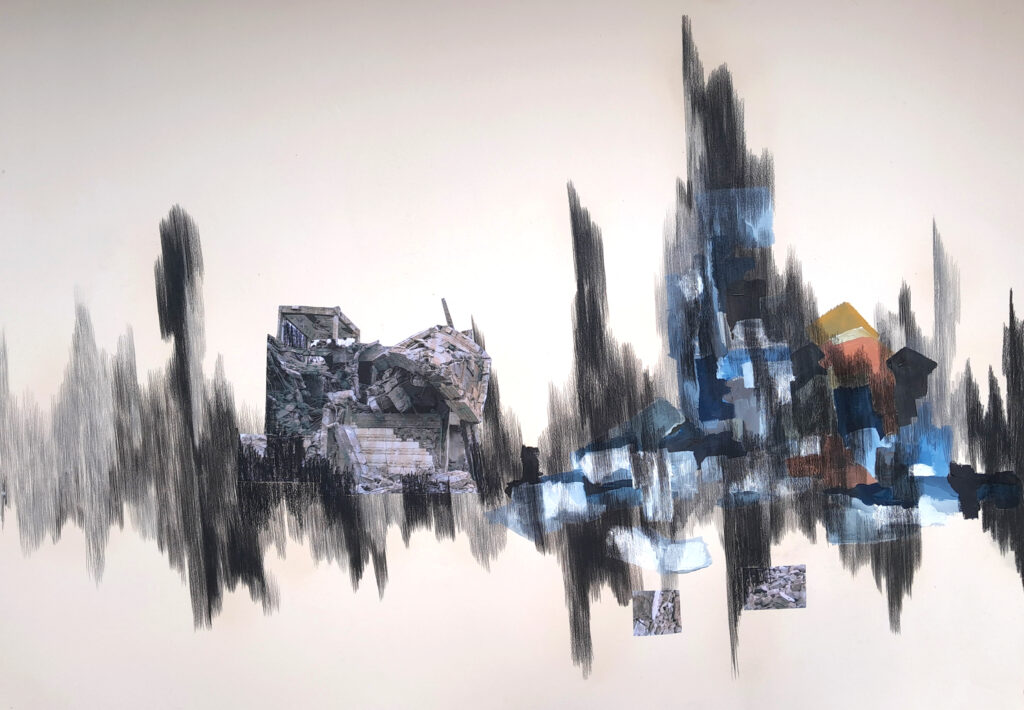
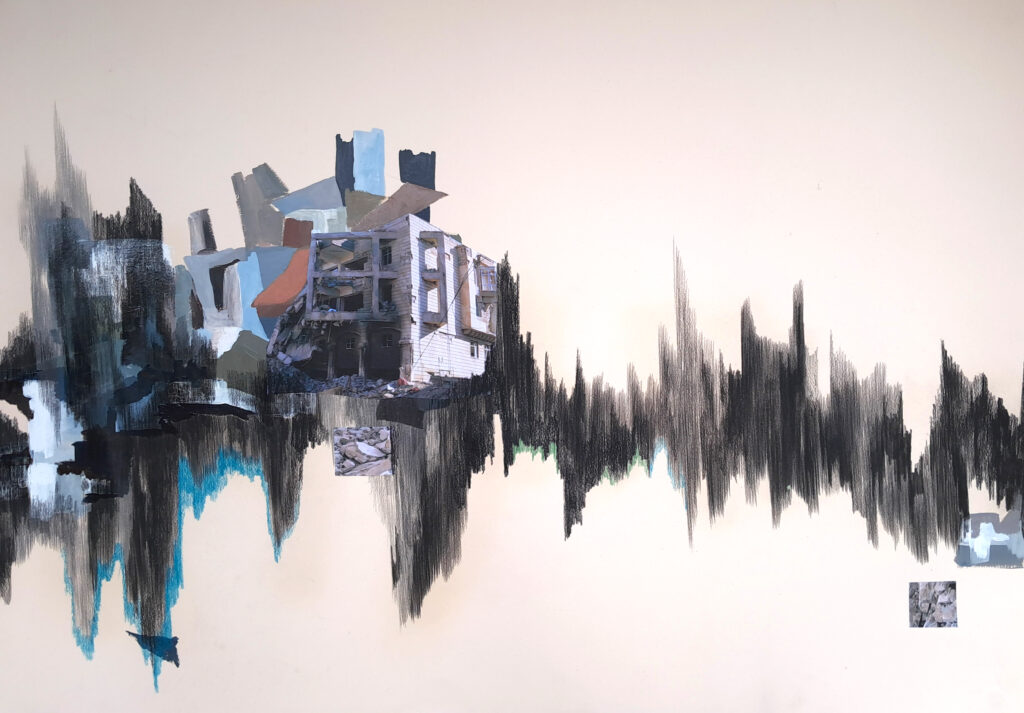
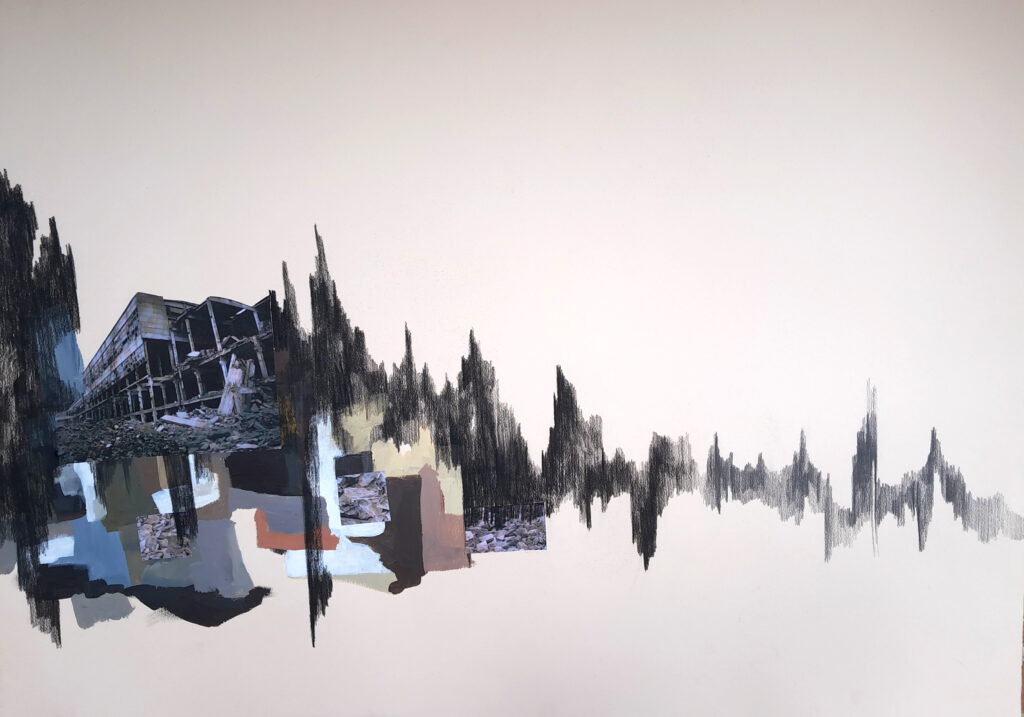
Memories for the Future I (triptych) | Charcoal, earth color, inkjet print, and colored pencil on paper
"Memories for the Future" represents the idea of conflict in a different manner. I feel that human rights and conflict are associated with each other in a very complex way. The complexities of war, the violations of armed conflict, and the imposition of suddenly made law led to the scenarios of migration, and the homeless, landless, and alienated self. These drawings are the experience of an encounter of my vulnerable self with the unstable present. "What have we become in the present?", is the question that triggers my mind to rethink our immediate surroundings and how, as humankind, we are creating an impact. Understanding the relationship between space and time with respect to the current situation around us plays a vital role in the process of analyzing the project. The acts of humans are becoming the reason for conflicts and constrictions of human rights. It is as if the motion of the wave has been set and is traveling into an enigmatic time. This act of the present will become a memory for the future.
My artist's book speaks about the silence, the truth, the motion, and the pace in the symbolic manner of one, at the time when they lost their land and home.
Nikita Bisht | Haldwani, Uttarakhand, India
Dwelling | Found objects (rocks, soil, fragments of slate stone)
Dwelling is a place or a house that metaphorically represents its current state in the region. It aims to represent the history and the elders who are remaining in the villages where the culture is being lost. Most of us in the region have migrated to the cities in search of accessible education and occupational opportunities, leaving lands and traditional structures behind and never planning to go back. The natives never return to see their own houses, which have become abandoned, the roofs fallen among leftover things.
In some parts of this region whole villages are emptied due to migration. They are called "ghost villages”. The artwork "Dwelling" poignantly depicts the impact of migration on human rights and cultural preservation, emphasizing the significance of art as a tool for raising awareness and highlighting the need for protecting the traditions and identities of the communities.
Pratap Manna | Kolkata, West Bengal, India
The Urban Inequality | Watercolour on acid-free paper
Urban inequality in India is a topic that is both pressing and complex. The pictorial space portrays a bustling cityscape, yet it is not the glitzy, gleaming metropolis that one might expect. Rather, it is a city that is divided, split in two by a line that separates the 'haves' from the 'have-nots'. On one side, we see towering skyscrapers and opulent housing complexes. On the other, we see slums where the poorest of the poor struggle to survive. The painting is a powerful reminder of the stark contrast between the privileged and the underprivileged, along with the urgent need to address the systemic issues that perpetuate inequality in our society.
P Cube Play | Yangon, Myanmar
1st Place Award Winner
Life Behind Bars | Photograph
“Life Behind Bars” represents the actual life of a Burmese person who has been detained for being involved in the revolution against the military coup in Myanmar. Sometimes the world and its people do not act fairly. But if they have power and money, all the things they do are considered right, no matter how wrong they are or how many people they are killing. The bars are like those in power. Whenever a person is trying to do what is right, the bars are there to prevent it. It is just that. However, there is always someone who believes he or she can bring about change.
Colors Are Dangerous | Dance performance video
We all feel and have experienced the influence and difficulties of the environment – being restricted, bullied, controlled, and ridiculed, in addition to things like being loved and praised. It is natural to see the good and the bad in the environment. We know that bad influences can have a greater effect on us, and we tend to become addicted to bad influences. In the end, we have to learn that both good and bad influences come from ourselves.
We would like to extend immense gratitude to all the artists and our partners
for making this exhibition possible!

